Revised 16 December 2021 with footnotes
By Eli Solomon
When Bernard Sydney Arnold 1 died in September 1963, aged 49, he left behind a legacy as one of the Far East’s most enthusiastic racing drivers. From the 1930s until 1963 this Briton raced in Europe (including, it seems, pre-war Brooklands), Macau, Malaysia and Singapore. This article is about B.S. Arnold as well as his primary mount, his Warrior Bristol.
A REAL WARRIOR
A REAL WARRIOR: What has been summarily referred to as a Cooper Jaguar began life as a Bristol-engined Formula 2 T23 Cooper Bristol of the early 1950s. The car was written-off in a crash at the Snetterton 2 race track in Norfolk, England in October 1953, and from its remains, an evocative aluminium body was fashioned by coachbuilders Williams & Pritchard 3 for its 25-year-old owner Rodney Nuckey in 1954. Rather than calling it the Nuckey Bristol, it was named the Warrior (and later registered SAR 336), after Nuckey’s family company in Hertfordshire – the Warrior Tap Tools and Die Company. The new frame was multi-tubular, with Cooper suspension and sprung by a transverse leaf at the front and here is where confusion arises 4.
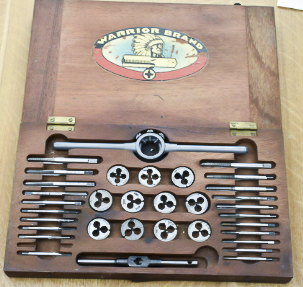
Many of us who work on our own cars will have used taps and dies from Warrior.
Were the frame and mechanicals (like the brakes) based on the MkI or MkII Formula 2 Cooper Bristol? We know it had a de Dion rear axle, and brakes were Lockheed two-leading-shoe hydraulic, but were they the 11-inch diameter (2.25-inch front, 1.75-in rear) separate Alfin light-alloy drums (as on the MkII Bristols) or were they 10-inch diameter by 1.75-inch wide cast magnesium-alloy integral wheels and drum brakes with Wellworthy centrifugally cast liners (as on the MkI Cooper Bristols)? Both MkI and MkII had twin brake master cylinders.
A SPECIAL
A SPECIAL: Bernard Rodger 5 (then of RJC Motors in Saltden, Brighton) scratch-built the new multi-tubular frame using the F2 car’s Bristol engine and gearbox 6. Rodger’s brief was to build it for Sports Car racing rather than adapt a Cooper Bristol T23 MkII single-seater tubeframe for the purpose. Perhaps that is why this car’s performance exceeded that of his Vignale-styled sports/racing car Cooper Bristol MkII-Alfa. Early photos of the Warrior in Singapore indicate that the car was tubeframed, the identical car featured in the 25 December 1953 edition of Autosport. But what of the brakes? The wheels, it appears (corroborated by The Autocar illustrations of the 1952 MkI Cooper Bristol) were off a MkI Cooper Bristol with integral drums and not the separate Alfin drums from the Cooper Bristol MkII cars. Technically, the Warrior Bristol was a Bernard Rodger Special, not a Cooper!
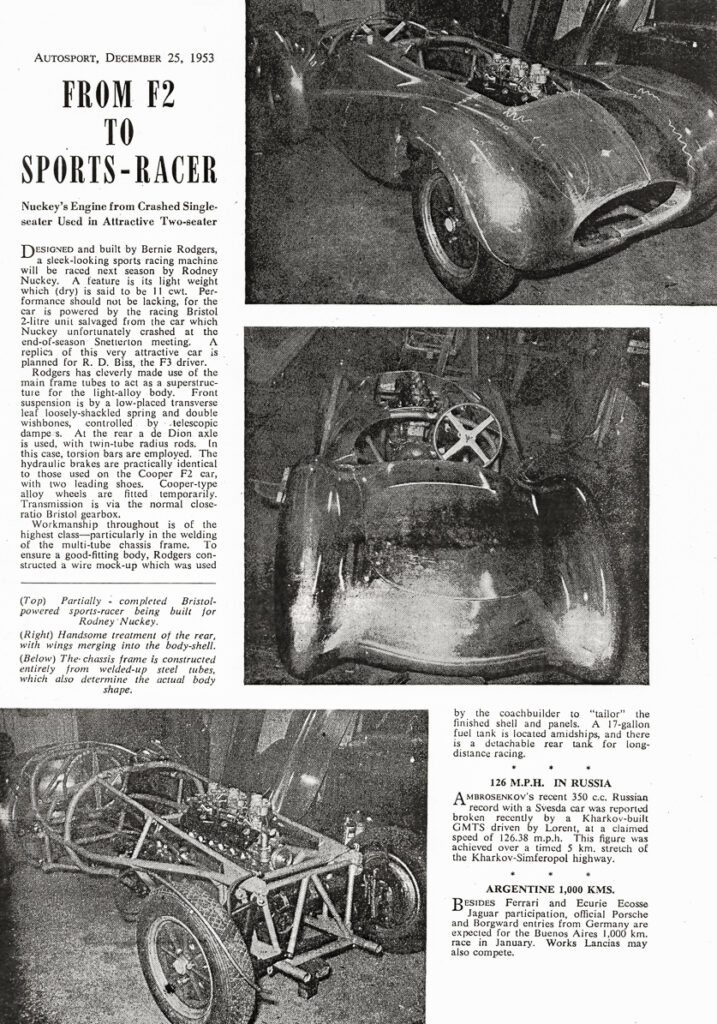
This Warrior Bristol in 1953, prior to the fitting of the rear tail fin. Source: Autosport, 25 December 1953. The chassis tubes and integral wheel/brake drum can be clearly discerned in the bottom photo.
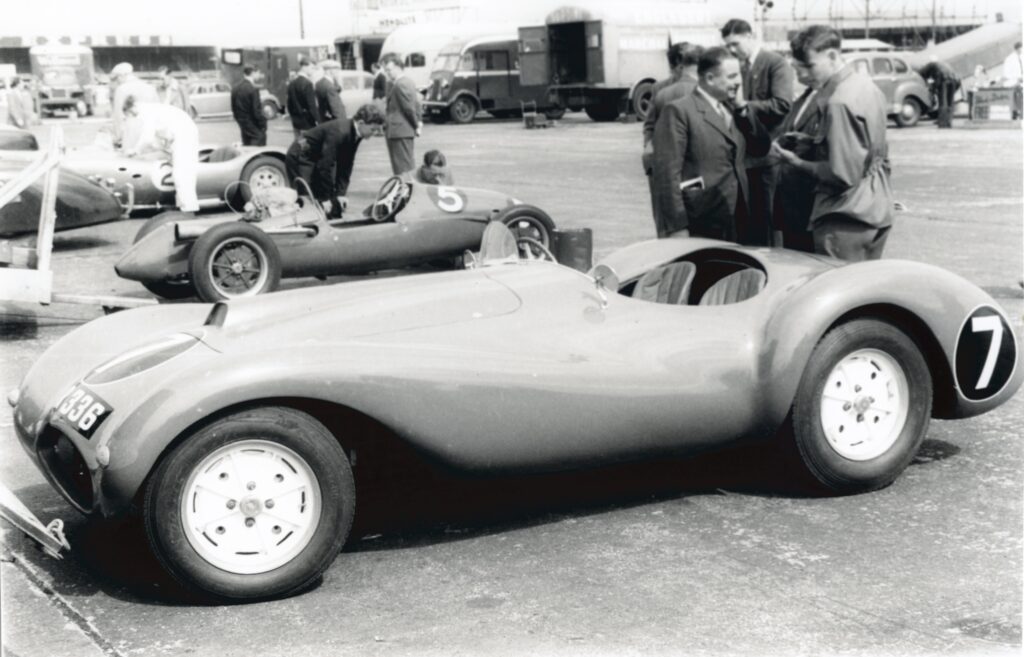
SAR 336 at Silverstone in 1955, prior to the appearance of the rear fin. The photo clearly reveals the Cooper Bristil MkI front wheels with integral drums. Source: Ted Walker.
The Bernie Rodger-built Warrior Bristol subsequently underwent its second and third facelifts in South East Asia, arriving in Malaya first as the Warrior Bristol before becoming the Cooper Bristol (What else would its owner have called it?), Cooper Jaguar and, as will be evident later on, Cooper’s Jaguar.
COOPER TIME
COOPER TIME: The Warrior, however, was not Bernard Arnold’s first race car in Asia. That accolade goes to a Malayan Special called the Lincoln Saphir 7 Special which Arnold showed up in at the Singapore Motor Club’s Lim Chu Kang Half-Mile Sprint in early February 1955, an event that attracted 102 entries. Everyone wanted that coveted sprint record which stood at 22.97 seconds in Singapore 8 (set by Chan Lye Choon) and 22.89 seconds in Malaysia (set by Chan’s elder brother, Chan Lye Huat) 9. Arnold’s car was not as fleet footed as those little Cooper JAP projectiles but there were class trophies at stake and Arnold and a certain Lt. Michael Vaughan Benthall 10 (of the 7 Gurkha Regiment) both had a go in the flathead V12 4-litre Lincoln Special (as well as an MG TC). Was this Lincoln V12 Malayan Special already active before Arnold acquired it?
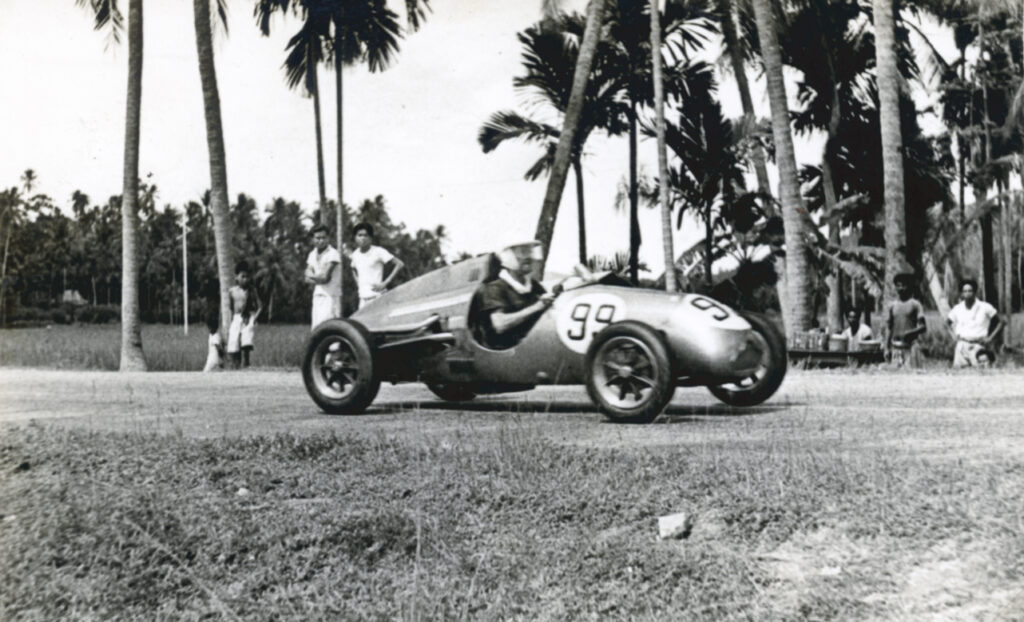
The Mk IV Cooper 996cc JAP with Dr. Barney Hassan at the Sungei Nibong Kilo Sprint, 30 May 1954. Arnold first appeared in this car at the 27 March 1955 Penang & North Malaya Motor Club Kilo Sprint at Sungei Nibong in Penang. 11
Not long after that, 40-year-old Arnold acquired the ex-Bill Ferguson 12 996cc Cooper JAP 13 , a very successful car that turned the sport on its head in Malaya – the first of a slew of Cooper JAPs (and a Kieft) that was to appear in South East Asia over the course of the early 1950s. By the time Arnold acquired the Cooper, Neil Moncrief 14 , Jimmy Milne 16 Municipal architect Jennings, who lived in Kuala Lumpur, was a regular participant at the Motor Club events up and down the Malay Peninsula, as was Arnold and many of the other white civilians and planters. Many of them brought their families along for the road trips to the sprints and hill climbs, foolhardy as it may seem to those of us accustomed to lockdowns and closed borders today.
Arnold entered the Cooper in the Singapore Motor Club’s Gap Hill Climb in the car in April and in May he set FTD at the 600 yard Klang Hill Climb up Kuala Lumpur’s Club Road with a 26.36 sec. time set in the Racing Cars Unlimited Class. Once more the car was shared with Barney Hassan. The Doctor took the class win in the Racing Cars up to 1100cc class with a 26.72 sec time. In November Arnold set FTD once more, at the second Klang Hill Climb with a 27.2 sec time.
A year later Arnold established a new Racing Car 1100-1500cc record at the Kuala Lumpur Lornie Road Kilo. He followed that up by smashing two Sungei Nibong Speed Trial records in May 1956: the 1500cc and under record at 27.9 sec and another for Unlimited class at 27.96sec.
In fact, the Cooper JAP proved to be as successful in Arnold’s hands as it had been with Bill Ferguson. But this was for the upcountry events when the Neil Moncrieff-Jimmy Milne and Chan Lye Choon-Chan Lye Huat Cooper JAPs were not competing. Work commitments at Tanah Merah Estate in Tangkak, or fear of bandits behind every blade of grass?
NEW WEAPON
NEW WEAPON: Meanwhile, back in Britain, Roger D. Biss and J.D. Lomas raced the newly built Warrior Bristol at Silverstone 17 and Aintree 18 in 1955, road registered SAR 336, assuming of course that the Biss car was not the proposed replica of the Nuckey Warrior that was meant to have been created.
Arnold, then an engineer at Tanah Merah Estate 19 in Port Dickson, Negri Sembilan, must have first heard of its availability when it was advertised for sale in July 1955 by J. Davy Ltd., Kensington High Street, by which time the car had gained a wraparound screen and rear faring cum tail fin. Its final advertisement by J. Davy Ltd. was in the 22 June 1956 edition of Autosport (see advert below).
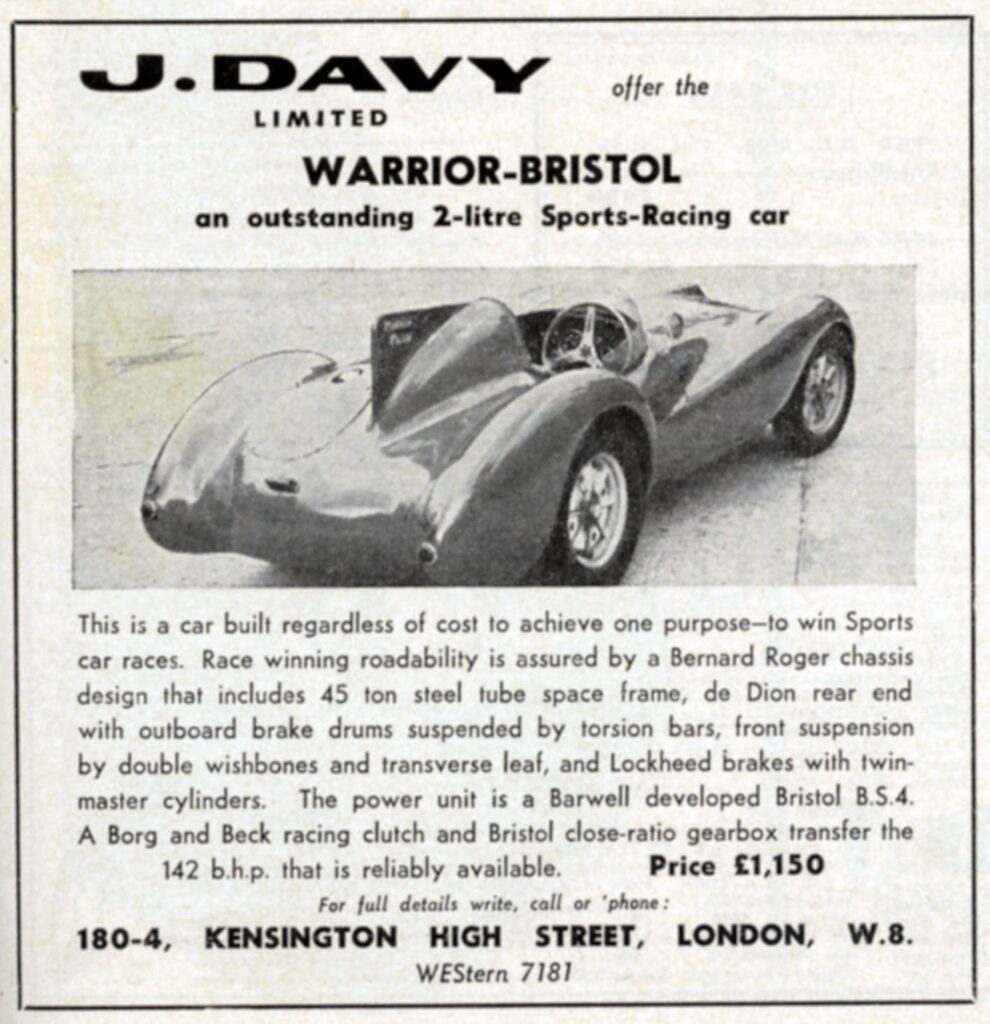
J. Davy Limited advertised the Warrior Bristol in Autosport Magazine (20 & 27 April 1956) without pricing, and on 22 June 1956 with price reflected at £1,150. The advert clearly reveals a special chassis frame had been constructed, including double wishbones at the front (the Cooper Bristols only had lower wishbones). Technically this car wasn’t a Cooper.
One Singapore press account is that Arnold acquired it for an astonishing $34,000 (£3,967) in October 1956 20. The last J. Davy Limited Autosport quarter-page advert for the Warrior Bristol is dated 22 June 1956. The advert read: “Race winning roadability is assured by a Bernard Roger [sic] chassis design that includes 45 ton steel tube space frame, De Dion rear end with outboard brake drums suspended by torsion bars, front suspension by double wishbones and transverse leaf, and Lockheed brakes with twin master cylinders. The power unit is a Barwell 21 developed Bristol B.S.4. A Borg and Beck racing clutch and Bristol close-ratio gearbox transfer the 142 b.h.p. that is reliably available.” Interestingly, the photo shows the rear wheels to be the Cooper magnesium type and pricing at £1,150! The price was considerably different to what Singapore’s media reported it as. As an aside, Arnold could have bought a fairly new Lotus Eleven Le Mans Climax with Stage II Climax motor for £1,150 or even the ex-Mike Hawthorn Cooper-Aston for £1,050.
Meanwhile the Cooper JAP continued to prove useful to Arnold at upcountry events, including setting FTD at once again at the Klang Hill Climb in August 1956, with a 27.76 sec time. The Cooper JAP, now occasionally shared with Keith Baker, was eventually sold to airman Jan Bussell 22. According to Arnold’s 47-year-old friend, industrial chemist Dr Freddy Marshall 23 [no relation to David Saul Marshall, then Chief Minister of Singapore (6 April 1955-7 June 1956)], the Warrior Bristol (with Bristol’s BS4 Mk2 and triple downdraft Solex) was “ordered for the 303-mile race at Guia circuit in Macao.” But Arnold was cutting it thin because the car was only expected to reach Singapore in the middle of October (suggesting that Arnold had acquired the car no later than the middle of September 1956) and did not make its intended trial run at the 14 October Gap Hill Climb before being shipped to Hong Kong.

Bernard Arnold and Dr Freddy Marshall shared drives in the 1956 Macau Grand Prix. The car was already road registered in Malaya, hence the Negri Sembilan registration plates, NA3.
First port of call therefore was the Macau Grand Prix where Arnold and co-driver Freddie Marshall were to share the drive, the car entered in Class E (which included R. Dodd’s Triumph TR2, Doug Steane’s Mercedes 190SL, Paul Du Toit’s Helvia Sunbeam-Talbot Special, D.S. Wrinch’s Triumph TR2, Neville Fullford’s Triumph TR3, da Costa’s Ferrari Mondial and D. Lloyd’s Triumph TR2). The Warrior set some very fast times during Friday’s practice in the dry but when it came to Saturday’s qualifying, the Warrior was behind the times set by Doug Steane’s 190SL, da Costa’s Ferrari and Bob Richie’s Austin Healey 100M. In the Grand Prix Arnold drove the first 20 laps (of 77) then handed over to Marshall. The latter put in some very quick laps, going from ninth to third, before spinning off and damaging the front end and radiator of the car on lap 49. “Frequent attention was necessary thereafter, and the Warrior finished the race well back, in 10th place [67 laps],” wrote the Autosport correspondent in the magazine’s 23 November 1956 edition. As an aside, the Warrior was also entered in the 15-lap Team Relay Race and Team A (Doc Marshall in the Warrior, George Baker in his Ford Thunderbird and Bob Harper in his Ford Prefect) finished second (the winning Team E consisted of I. Granger, J. Winder and Freddie Pope).
Arnold had the damage repaired (you can tell the difference in the accompanying image below) then ran it at the fashionable sprints and hill climbs up and down the Peninsula, part of the clique from the foreigner-dominated Singapore Motor Club. But Macau was the new playground for the affluent enthusiasts from Malaya and Singapore. The Warrior returned there the following two years, in the company of several Singapore cars such as Phil Caroline’s Allard J2X, Chan Lye Choon’s Aston Martin DB3S [see FOR THE PRICE OF A HOUSE], Bill Wyllie’s DKW 1000RS [see ON THE STROKE OF TWO as well as BAMBOO & BUCKLER], Jan Bussell’s Berkeley and Freddy Pope’s Jaguar XK140 Monoposto Special.
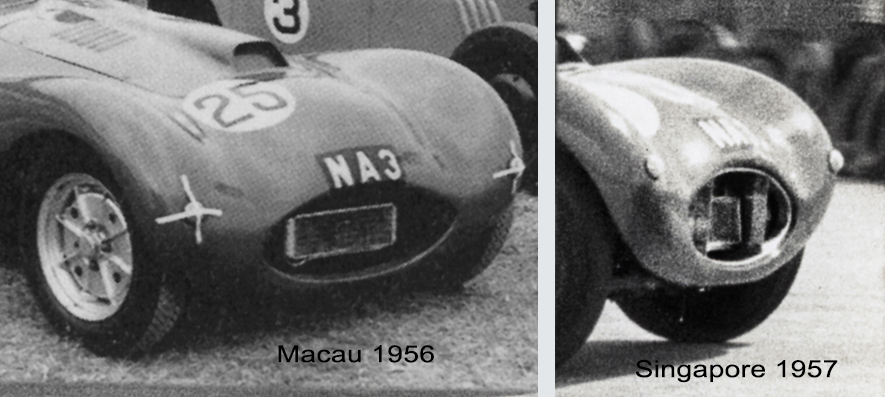
Left: The front end of the car in November 1956, prior to Doc Marshall’s front end damage in the Macau Grand Prix; Right: The car in late 1957, showing the change in design to the front snout following repairs in Singapore.
Following remedial work on the front end, the Warrior Bristol made an unsuccessful Lim Chu Kang Half-Mile Sprint debut in Singapore on 24 March 1957. A choked carburettor spoilt Arnold’s fun. Next stop was the Lornie Kilo in Kuala Lumpur on 5 May 1957, where Arnold took a class win in the 2,250cc and under class, with a 31.00 sec time (FTD set by Lim Peng Han in his Lim Special in 28.46 sec). Arnold’s fastest time was 30.80 sec. set in the Unlimited Sports Cars class which was won by Freddy Pope in his Jaguar XK140C in 28.59 sec. Keith R. Baker had a go in the Warrior, winning the Racing Cars 2,000cc class. Second, also sharing the Warrior once more, was Dr. Freddy Marshall. Captain Elwyn Jones had a crack in the car as well, finishing third in the Racing Cars Unlimited class.
The Warrior was really putting on the miles getting to and from events. The Gap Hill Climb on 12 May 1957 was the final test before the Changi Circuit Races in June. Third in the Unlimited Sports Cars class was all Arnold could muster, behind Chan Lye Choon’s Aston Martin DB3S and Freddie Pope’s Jaguar XK140C. The Warrior Bristol and its two-litre Bristol BS4 motor were not conceived for short sprints or hill climbs in the tropics but Sports Car racing around a proper race circuit. Changi beckoned in June 1957. Then all hell broke loose.
GRAND THEFT
GRAND THEFT: It was a frantic week for Arnold; the front wheels of the royal blue Warrior were stolen from his Fourth Avenue home in Singapore. The theft made the front page of Singapore’s Straits Times on Thursday 6 June 1957 24 (as well as on the 7th and 8th June!), just before the Changi circuit races [see LANDING AT CHANGI in 1957 ]. Police recovered the two front wheels by Thursday afternoon (they were discovered to be missing on Monday) but nothing else was revealed.
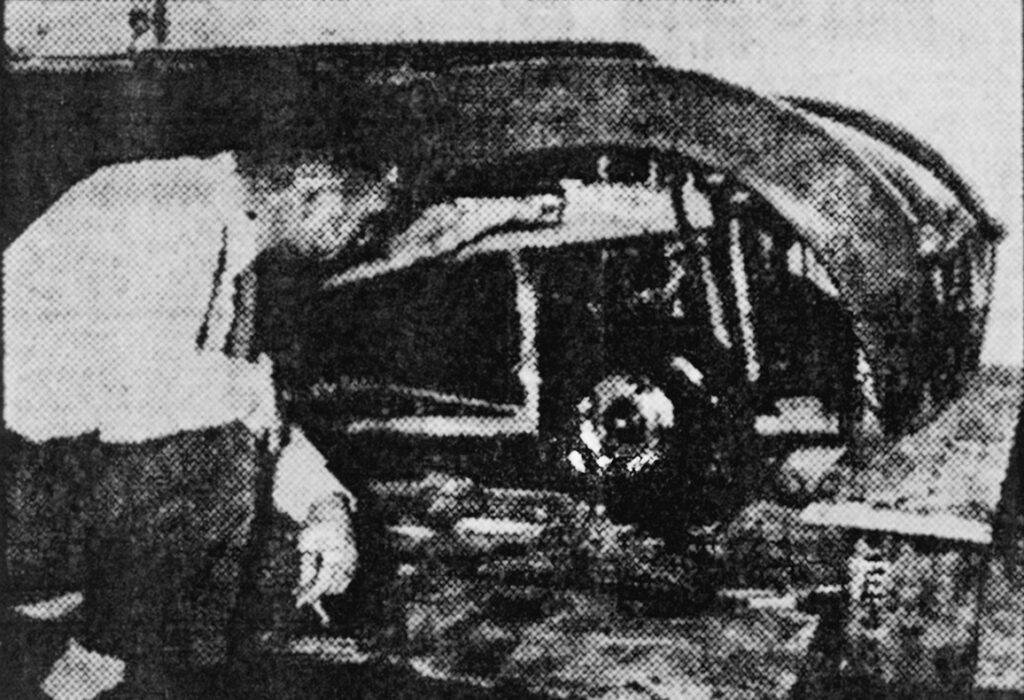
Bernard Arnold made the frontpage news in Singapore’s Straits Times on 6 June 1957 for all the wrong reasons. The photo shows Arnold kneeling by his wheel-less Warrior Bristol, revealing just the twin leading brake shoes and no drum – an indication that this was a MkI Cooper Bristol brake set-up with the integral wheel/drum. No wonder Arnold lamented that he could never find a replacement set of wheels!

Bernard Arnold and his Warrior Bristol at the Changi Circuit Race in 1957.
That weekend [See LANDING AT CHANGI IN 1957], the royal blue car was one of the undisputed favourites to win. Just before noon on race day, the Bristol engine started to misbehave. Two friends, Keith R. Baker and Captain Elwyn Jones, and Arnold, worked frantically on the 142bhp BS4 Mk 2 motor for three hours before it was running well. It was just enough to give Arnold a third place finish.
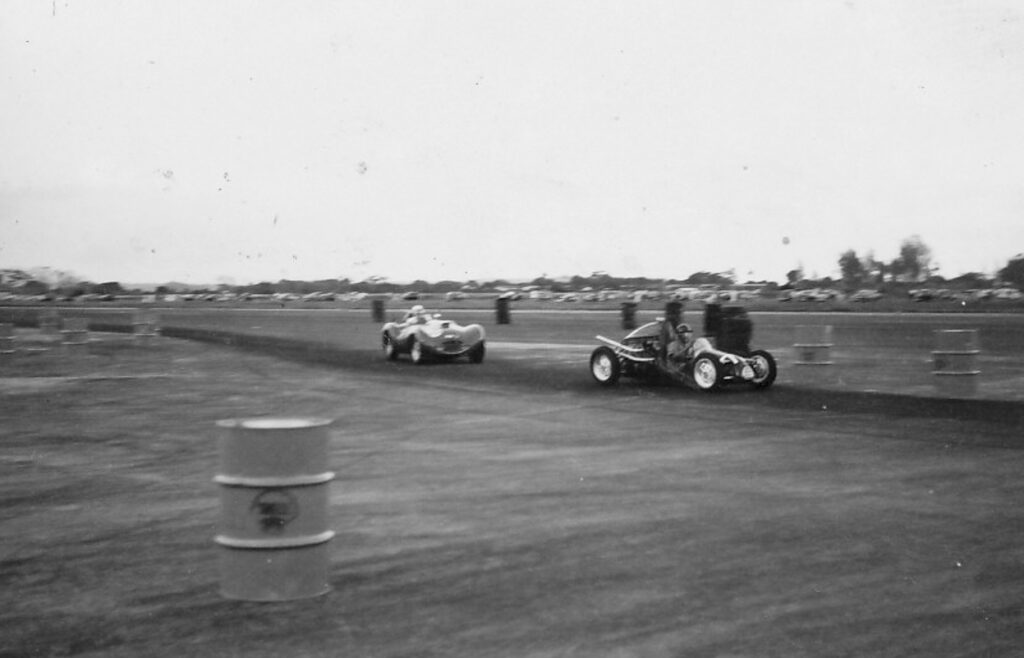
Running in formation – Arnold chases Lim Peng Han’s Lim Special (the ex-Kieft Mk1A), the pair finishing in that order with Chan Lye Choon winning in his Aston Martin DB3S.
Baker and Jones were also running the 130mph 4.5-litre V12 Lincoln Saphir Special of Arnold’s at Changi so it was a rather hectic weekend for all of them though Baker’s job at Guthrie’s building materials department enabled him to procure a three-car Numax inflatable hut for the cars in the Changi paddock 25.
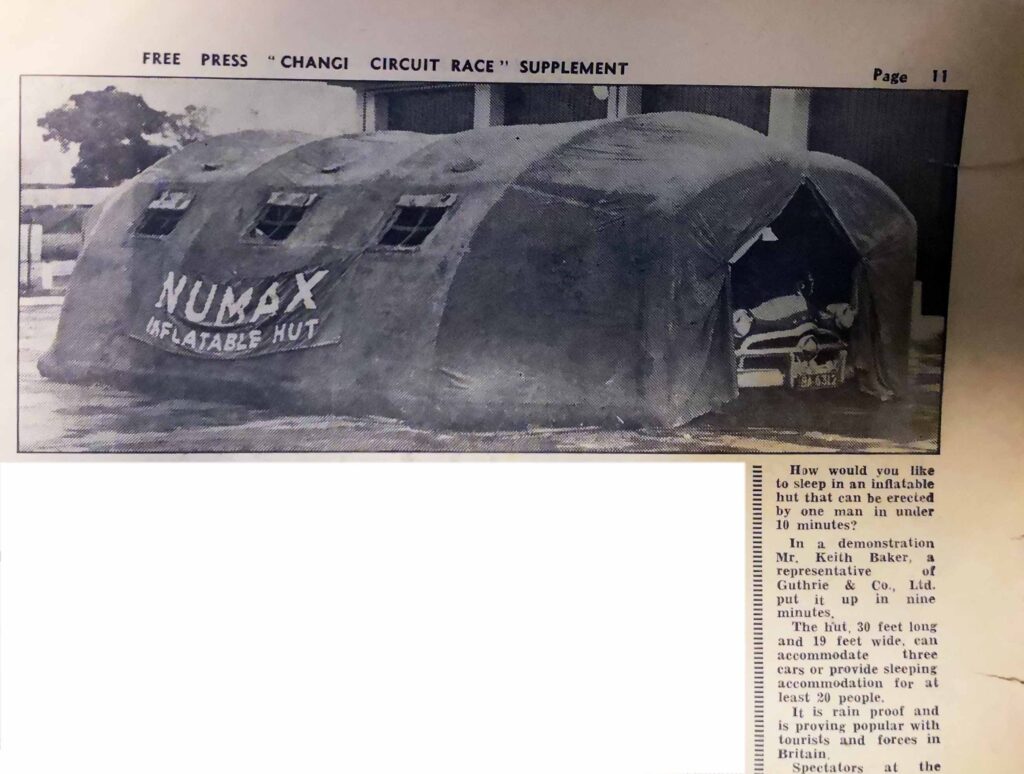
Guthrie’s 30-foot-long and 19-foot-wide rainproof inflatable hut for Bernard Arnold’s Lincoln V12 Special, Warrior Bristol, and a third car. Perfect marketing strategy at the races.
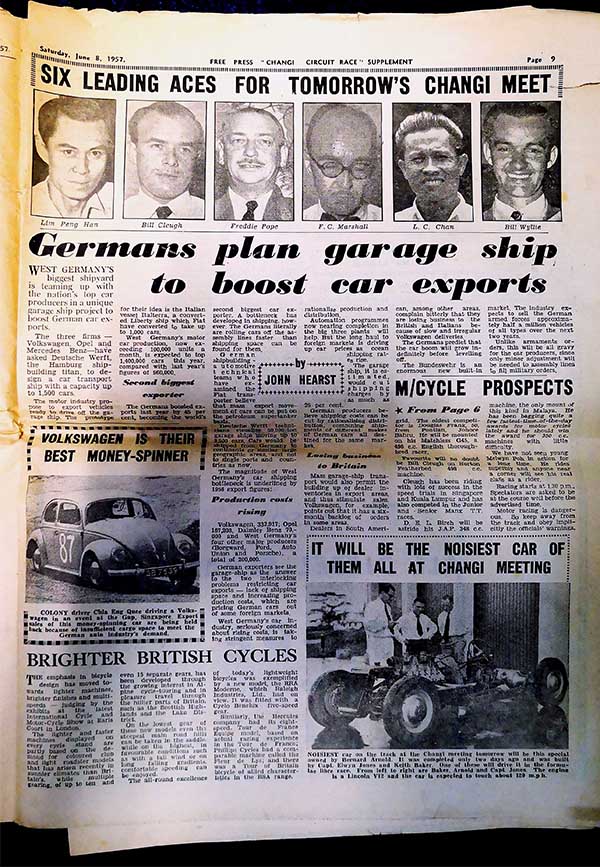
The Lincoln V12 was featured in the Singapore Free Press’s Changi Circuit Race Supplement (bottom right).
Both Pope and Arnold were up for another trip to Macau in November 1957, Arnold missing early October’s Gap Hill Climb in Singapore as a result. The Warrior Bristol was loaded on board RIL’s small but well-appointed passenger liner MS Tjiluwah on Wednesday 6 November. This time Arnold was prepared – the cargo included spare Cooper wheels, just in case someone tried to steal them again. 26 Success in Macau in November wasn’t forthcoming for 43-year-old Arnold as the car was plagued by engine trouble in the race.

Bernard Arnold was prepared for Macau. Following the debacle of stolen Cooper wheels prior to the Changi Races in June 1957, his carry-on included a pair of spare front Cooper wheels with integrated drums, just in case. Source: Singapore Free Press, 8 November 1957, pg. 15.
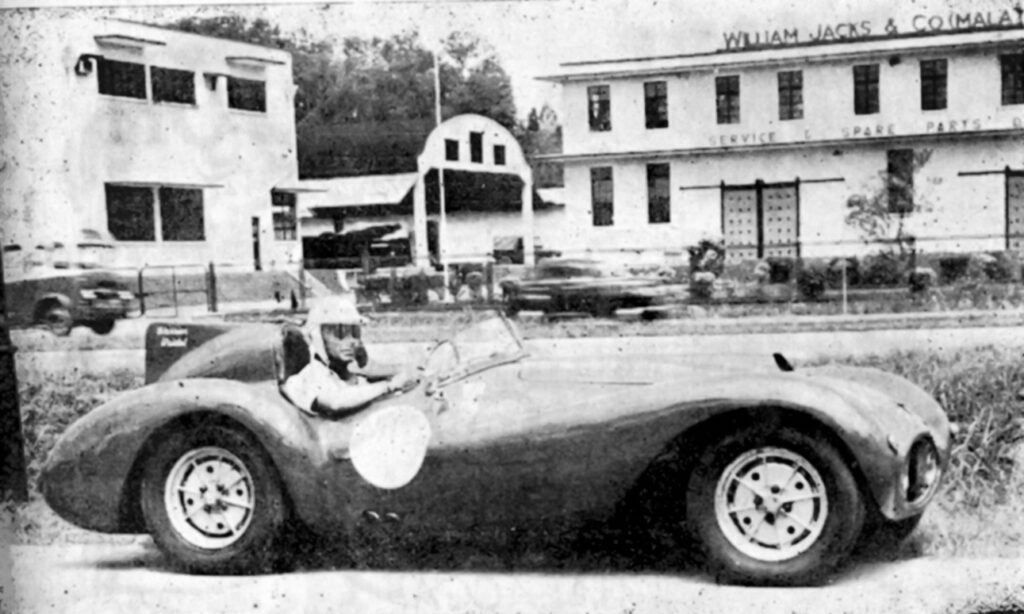
Another early photo of Bernard Arnold and his Warrior Bristol but now with Cooper rear wheels suggesting this was a post Changi Circuit Race (June 1957) photo 27. William Jacks were the local distributors for Timken automotive bearings and fire-fighting equipment.
There was always the dozen or so sprints and hill climbs to while away the lazy tropical weekends in Malaya. Arnold, now working for the East Asiatic Company’s engineering department, was restless. Time to look at starting up something on his own, outside of his day job.
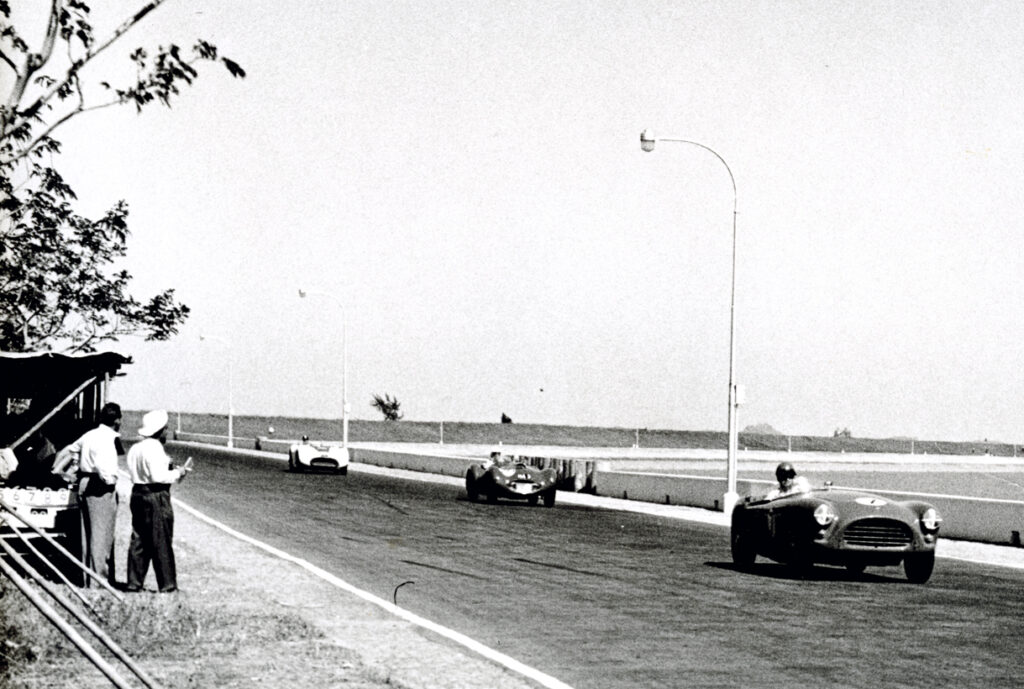
Bristols to the fore. Arnold’s #25 Warrior Bristol chases Ron Hardwick’s #7 AC Ace in the 1957 Macau Grand Prix. Arnold also raced in the Production Saloons support race, in a Ford Zephyr Mk2.
1958 beckoned but Arnold nor his Warrior was at the Lim Chu Kang Sprint on 23 March 1958. Neither was he upcountry at the Sungei Nibong Penang Kilo Sprint during the same weekend. Perhaps he may have attended the Klang Hill Climb, also held during that same weekend though we don’t have the race program or results to determine if he was indeed there. Arnold was not at the Gap Hill Climb on 11 May 1958 or at the Simpang Pulai Hill Climb that same weekend. We don’t find him in the records of the Forces Motor Club Malaya Rally on 8 June 1958 or the Seremban Half-Mile Sprint on 13 July 1958. This gap of over seven months without racing for Arnold between the 1957 Macau Grand Prix in November (he returned to Singapore on 21 November) and his next appearance in early July 1958 suggests work was being done on the car/engine during the period.
However, he made an appearance at the Princess Elizabeth Estate Sprint on 6 July 1958. The Warrior, running #23, took the Unlimited Sports Cars class win in 1 min 46.72sec. Arnold finished third in the Racing Cars Unlimited class in a slower time, against Lim Peng Han (who set FTD) and Bill Wyllie in the Triumph-engined Buckler DD2 [see BAMBOO & BUCKLER]. He was also third in the 2000cc and over Sports Car Class. Arnold then skipped the Malayan Motor Sports Club’s newest sprint event at Sungei Kantan Estate in Kajang, Selangor set for 27 July 1958). 28 Arnold appears to have missed the Perak Motor Club’s Merdeka Half-Mile Tiger Lane Sprint held on 7 September 1958, the Forces Motor Club Dover Kilo on 21 September 1958 as well as the Gap Hill Climb on 12 October 1958 although this may have been due to preparations for the upcoming Macau Grand Prix in November.
NEW LINE
NEW LINE: It was an exciting final quarter of 1958. Macau saw a Singapore invasion with eight entries headed over for the Grand Prix on 16 November: Freddie Pope, Phil Caroline and Neil Moncrieff (sharing Caroline’s Allard J2X), Chan Lye Choon, Jan Bussell, Rex Carkeek (entered in one of Chan’s Citroën in the Saloons races), Bill Wyllie [Wyllie Special – see BAMBOO & BUCKLER] and Bernard Arnold eclipsed the previous year’s five entries from Singapore. Pope had two entries – a 3.4-litre saloon in the Saloon races and his tubular frame Jaguar XK Special in the Grand Prix.
Arnold and Bill Wyllie’s cars were sent on the Glenearn for Hong Kong on 31st October while Chan’s Aston Martin DB3S and Phil Caroline’s Allard J2X went on the Chusan the following day. In the end, Arnold’s Warrior Bristol finished the race in the top ten (of 13 of the 24 who started the race). Macau never was forgiving and exposure to circuit racing was non-existent (Changi 1957 aside).
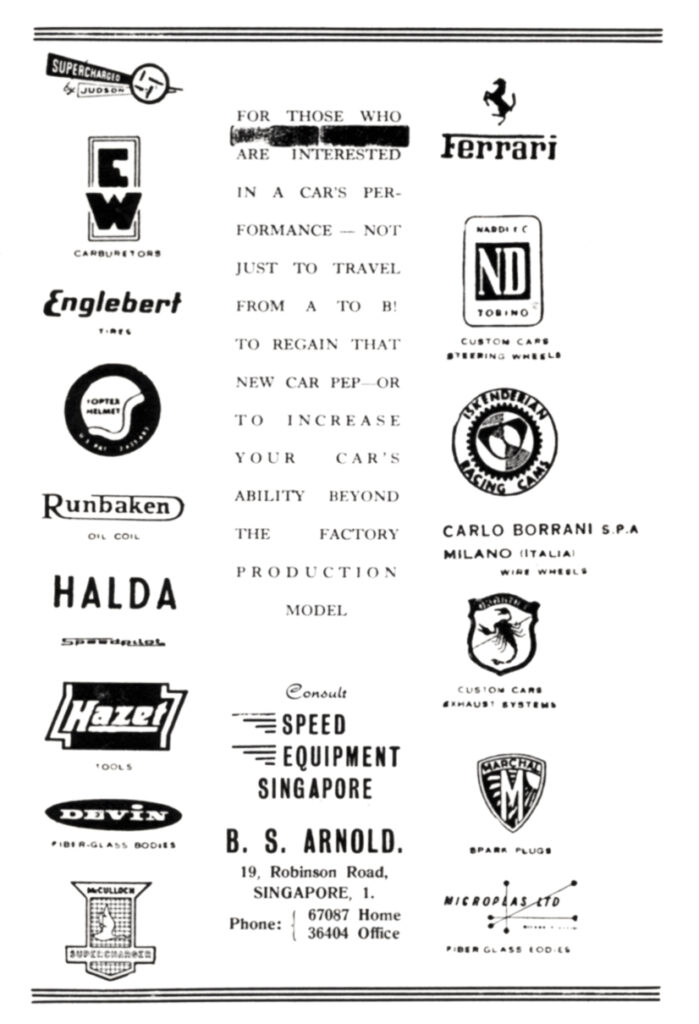
Bernard Arnold’s Speed Equipment Singapore advert in the December 1958 edition of the Singapore Motor Club’s Gazette, soon after he quit his job at the East Asiatic Company in Singapore. This advert predates his Chequered Flag Engineering workshop.
Arnold made his move in late 1958 and set up a speed shop on Robinson Road at the heart of Singapore’s business district, address at 19 Robinson Road. “A welcome entry into Singapore’s motor world and long overdue,” wrote Freddie Pope, President of the Singapore Motor Club in early 1959. Arnold’s stock was mainly Italian and American goodies such as Judson superchargers, Englebert tyres, Weber carburettors, Nardi steering wheels, Iskanderian racing camshafts, Borrani wire wheels, Abarth exhausts, Marchal spark plugs, Halda lighting and fibreglass bodies from Devin and Microplas. It was shortlived because soon after, Arnold set up Chequered Flag Engineering.
Most, if not all, the Macau entrants from Singapore had made it back home by January. The Dover Kilo was held on 25 January 1959 and the turnout was good. Freddie Pope, Phil Caroline, Bill Wyllie and Chan Lye Choon featured in the Dover Kilo results but Arnold and his Warrior Bristol remained absent. The January event also saw the appearance of Tunku Mahmood of Johore 29. The Tunku, who had yet to become Tunku Mahkota (Crown Prince) of Johor (that took place in May 1959), won his Sports Cars class by beating his friend Stanley Leong and Dr Freddy Marshall.
Arnold made an unusual appearance upcountry on 22 February 1959 when the Perak Motor Club organised a grass track autocross event at the Polo grounds of Kuala Kangsar (which was just north of Simpang Pulai and south of Tanjung Rambutan). Arnold (racing his Warrior Bristol) was the only outstation competitor! The event was unusual in that it was a five-lap timed race, with each car sent off at 10-second intervals. The Sultan of Perak 30 flagged off the event which saw a crown of 10,000 attend (according to local press reports). Arnold finished first in the 1500cc and over Sports Cars class beating a M. Newham (Jaguar). But what was Arnold doing so far up in Perak with his Warrior in the first place?
In March Arnold entered the Warrior Bristol in the Singapore Motor Club’s very popular Lim Chu Kang Half-Mile Sprint held on 15 March 1959. The Warrior finished second in 3,000cc and Under class (behind Chan Lye Choon and his Aston Martin DB3S) and first in the 2,000cc and Under Sports Cars Class, beating Barry Swann (AC Ace) and Chia Eng Quee (Rover Special).
A month later Arnold and the Singapore enthusiasts drove up to Malacca for the Malacca Half-Mile Speed Trial at Batu Berendam (held on 12 April 1959). There were 119 entries for this event, the fifth Malacca Speed Trial. The last one was held in 1954, hence all the interest in what was once a very popular event that always attracted entrants from Perak, Selangor and Singapore. Arnold’s #99 Bernard Arnold finished third in the Sports Cars unlimited class, behind Barry Swann (AC Ace) and Phil Caroline (Allard J2X). Arnold did win the Racing Cars 2,500cc and under class, beating Bill Wyllie (Wyllie Buckler DD2) and Bruce MacRae-Smith (in Mike G. Spragge’s Lea Francis Special 31). He also finished second in the Racing Cars unlimited class, behind Jan Bussell (in Arnold’s old Cooper MkIV JAP) but ahead of B.W. Kelly (Triumph TR3).
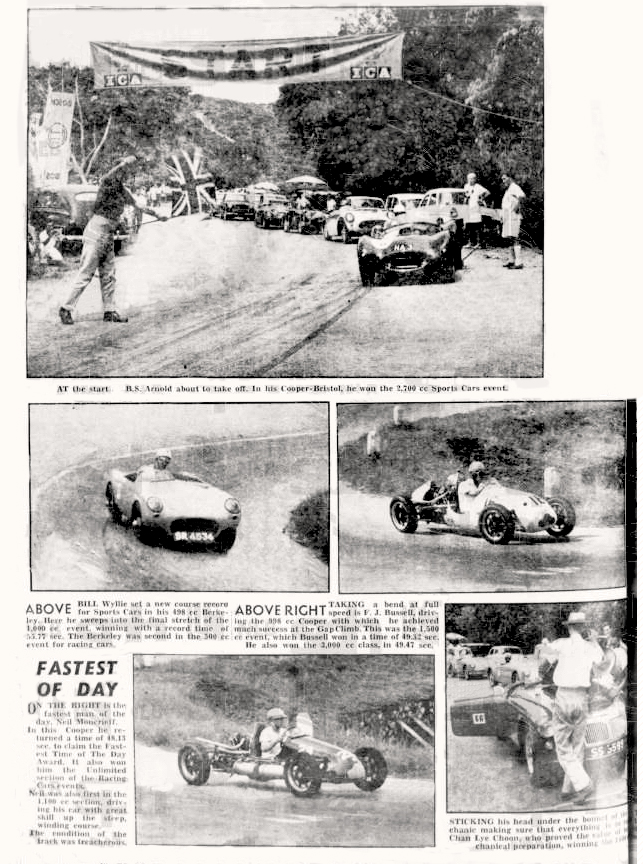
Gap Hill Climb – 24 May 1959. Bernard Arnold’s Warrior was outclassed in the Racing Cars 3,000cc and Under by Jan Bussell in his old Cooper MkIV and by Bill Wyllie in his Wyllie Buckler DD2 Special. Arnold redeemed himself in the Sports Cars 2,000cc and Under class, winning ahead of Brian Mills in a Triumph TR2. He found it harder in the Sports Cars Unlimited class, and was unable to match the space of Wyllie, Chan Lye Choon (Ferrari Monza – see JUST THE RIGHT AMOUNT OF TORQUE) and Eric Ooi (Triumph TR Plus). It was the same in the Racing Cars Unlimited runs, the Warrior unable to match the Cooper JAPs, Lim Peng Han’s Lim Special or the Wyllie Special. Image Source: Singapore Free Press, 29 May 1959, Pull Out on pg.8 & pg.9.
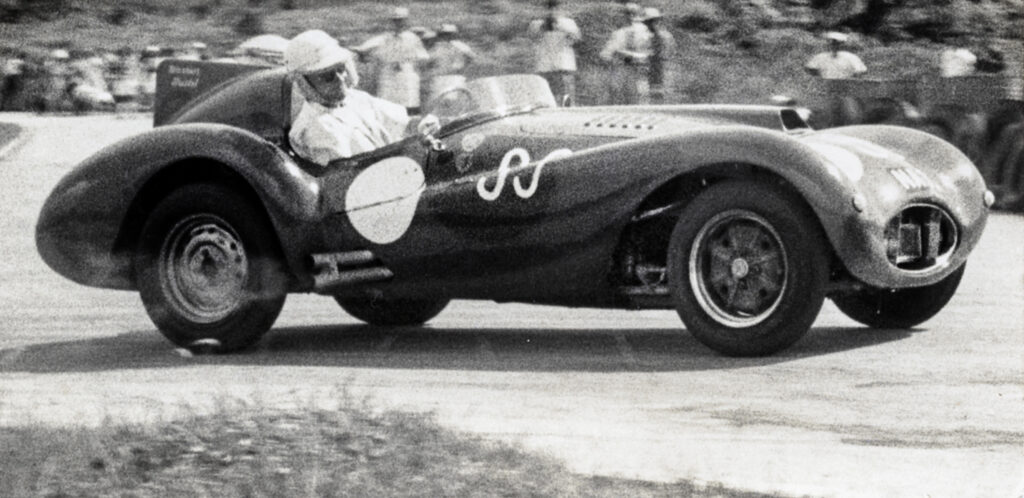
The Warrior Bristol at the Sembawang RASC Nursery Circuit in June 1959, still with its Williams & Pritchard bodywork, de Dion rear end and Bristol BS4 motor but without Cooper magnesium wheels in the rear.
While we are unsure if Arnold and his Warrior attended the Seremban Sprint on 29 June 1959, we do know that on 14 June 1959 he was at the Forces Motoring Club’s Sembawang Speed Trial at the Royal Army Service Corps Driver Training Nursery Circuit on Sunday 14 June 1959. This was the first such event at the tough and hazardous 1.25-mile circuit and consisted of a flying start sprint, not a massed-start event for cars (it was a mass-start for the motorcycles). Loris Goring was the Motor Club’s Editor and photographer and the club’s first magazine Editor32. “The big drawback about this little track is, as many people learn to their chagrin, the solid concrete kerb which severely restricts available road width to twenty feet. Aintree, a right angled right hander, quickly established itself as the “the” corner…” Arnold finished second to Chia Eng Quee (Rover Special) in the Racing Cars class.
There was one other highlight of the Sunday at Sembawang. Arnold’s regular appearance at the Macau Grand Prix and his association with Hong Kong’s Ferrari importer (and racer) George Baker manifested itself with the appearance at Sembawang of a most interesting Ferrari. At $42,000 33 it was going to appeal only to the local tycoon. George M. Baker came down to Singapore to demonstrate the car during the day with a run around the circuit, the first time the locals had seen such an exquisite car and the first time a sprint event was held at this “circuit”, replacement for the Dover Road Sprint (which was originally scheduled for 6 September 1959). Arnold then had the Ferrari 250 GT Roadster on display in his Chequered Flag Engineering Works showroom. Battista “Pinin” Farina himself was in Singapore to talk about the Ferrari 34 and the Sunday Standard newspaper upstaged the Straits Times’ Sunday Times (as it had consistently done when it came to motoring matters) with a road test feature of the Ferrari (the Sunday Times managed to squeeze in a feature on a continental car, albeit a rather less glamorous NSU Prinz).
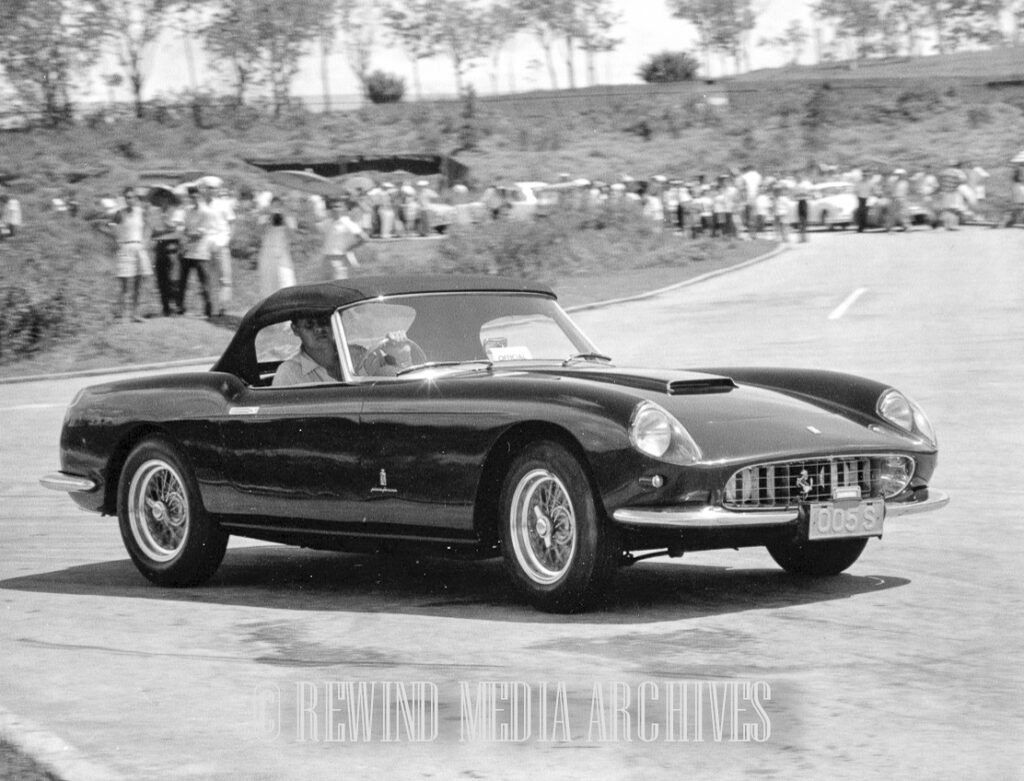
The $43,000 Ferrari 250 GT Roadster at the Sembawang RASC Nursery Circuit in June 1959, brought in by George M. Baker (his International Service Corporation Ltd. Hong Kong was the Far East Ferrari distributor). Bernard Arnold’s Chequered Flag Engineering was the Ferrari distributor for Singapore and Malaya, Ferrari’s first in that part of the world. The photo shows Eastern Auto’s Chan Lye Choon testing the car with his company’s trade plates on.
FACE LIFT
FACE LIFT: The Princess Elizabeth Estate Sprint on 19 July 1959 was a disaster for Arnold and his Warrior Bristol. Poor organisation of marshaling saw poor Arnold having to take drastic action to avoid spectators crowding on the escape road. The car clouted a curb in an attempt to avoid a major catastrophe, the car crashing into the judges’ enclosure without hurting anyone. It wasn’t the only case of a damaged car that Sunday, Chew Chek Leun’s attractive Simca Special (road registered S6363) spun and ditched itself after Marshall’s Corner and had to be towed home. The Warrior too needed a hand to get the car back to his Davidson Road workshop; the damage done on his last run in the Racing Cars class event broke the car’s front suspension. Fortunately Arnold had his Chequered Flag Engineering Works now in full swing. He was his own good customer – “remodelling the front of his Cooper-Bristol.” So there we have it – the first mention of a full facelift for the car during it sojourn in South East Asia (the 1956 facial post Macau 1956 was just that). It was possible after this accident that the front suspension was modified – by adding torsion bars to the existing underslung transverse leaf set up.
The Sembawang Sprint, organised by the Forces Motoring Club on 6 September 1959, was a unique event. It was really a circuit that the motorcyclists had already used for a mass-start race. The cars, on the other hand, were limited to single runs. Still, it was a circuit with appropriate names, and an opportunity to exercise a car in preparation for a possible Grand Prix. Arnold was entered, and so was Champion Motors’ Chia Eng Quee.
The Warrior was lent to Champion Motors’ Chia Eng Quee for the RASC Nursery Circuit event. As alluded to earlier, this was a hazardous circuit. Evocatively-named corners and straights such as Goodwood Straight, Aintree Bend, Silverstone, Shell Corner, Snetterton Straight, Vanwall Bend and Brooklands Corner greeted the drivers but that about it. It was also a circuit that took no prisoners, thanks to the solid concrete kerbs. Chia found the Warrior a little too potent for his liking.
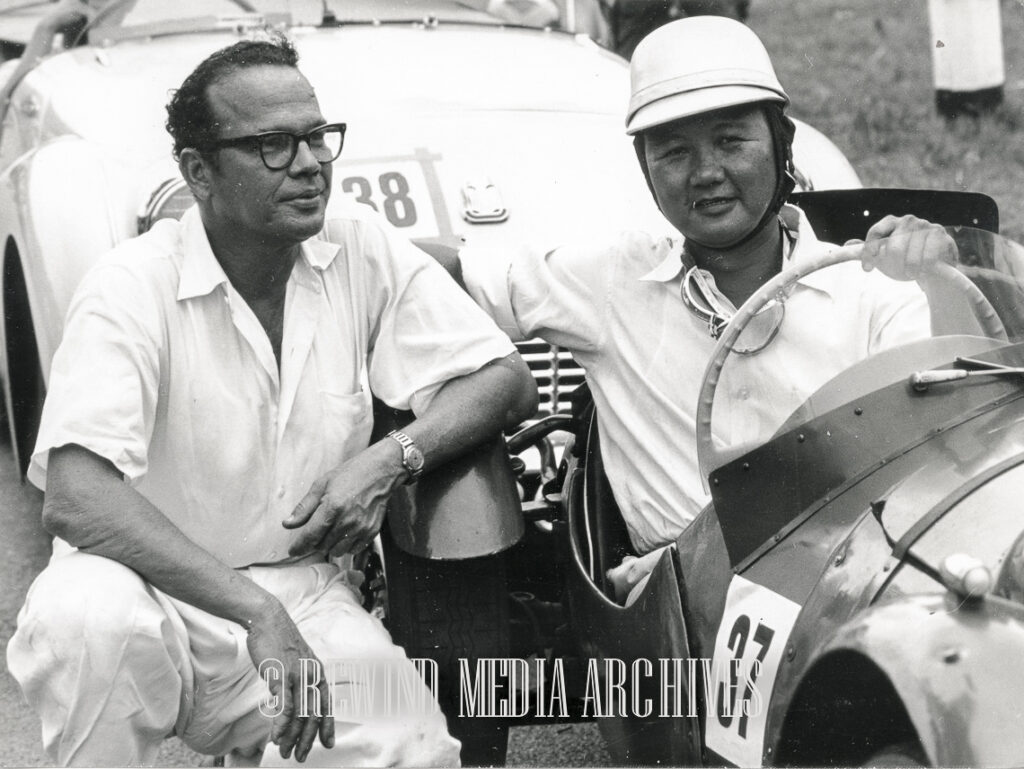
Chia Eng Quee with Rover Special in 1959. By his side is friend and fellow competitor Jimmy Milne. Few locals had had any sort of exposure to single-seater Formula cars. Chia just about destroyed the Warrior Bristol at Sembawang in September 1959.
The story is best told by the scribe in the Singapore Motor Club’s Gazette: “Eng Quee forsook his Rover Special to try the potent Warrior, and found it too potent altogether. After skilfully averting disaster on Aintree due to approaching too fast, he completely overshot Vanwall Bend, mowed down a row of banana trees, and came to rest on his side in the grass. Chia was only slightly hurt, but the car suffered extensive body dents, and a damaged de Dion tube. Bernard had just built a lovely new nose on it after Princess Elizabeth, too…Which just goes to show, the Cooper Bristol must be a bit of a handful, because Eng Quee is no mean driver.” One bent de Dion tube and some major remodelling work kept the Chequered Flag Engineering boys busy for some time – yet again. Arnold’s grief was further compounded when the Bristol’s cylinder head gave up the ghost after another class win at the Gap Hill Climb in October 1959.
At the 4 October 1959 Gap Hill Climb, the remodelled Warrior won Class 19 – for Sports Cars 2,000cc and Under, beating Barry Swann in the AC Bristol and Brian Mills in the very rapid Triumph TR2 though the Cooper’s time could not eclipse the class record set by Chia Eng Quee in the Eng Quee Special (set in October 1957). Arnold was unclassified in the Class 21 event for Sports Cars Unlimited, the Cooper’s times off the pace set by Wyllie in the Wyllie Special, Fatso’s Delight (BN1 Healey) and Tony Huggett’s Lotus Eleven Climax. It appears that the Bristol’s cylinder head suffered some damage (a cracked head it seems) after his class win – which probably killed off any hope Arnold had of racing in Macau in November.
There was a thriving club scene up and down the Malay Peninsula and Arnold’s Chequered Flag Engineering Works at 2 Davidson Road, off MacPherson Road in Singapore in 1959, must have seen a fair share of the motor racing business even though it must have appeared more as a hobby than anything else. In may not have been a happy time for the engineer in 1958 and most of 1959 with his private life but outside of home affairs, it seemed that everything was happening for him. Arnold left The East Asiatic Co.’s Engineering Department on 31 October 1958 35 and we can date the establishment of his Speed Shop (and shortly after, his Chequered Flag Engineering Works) to that period.
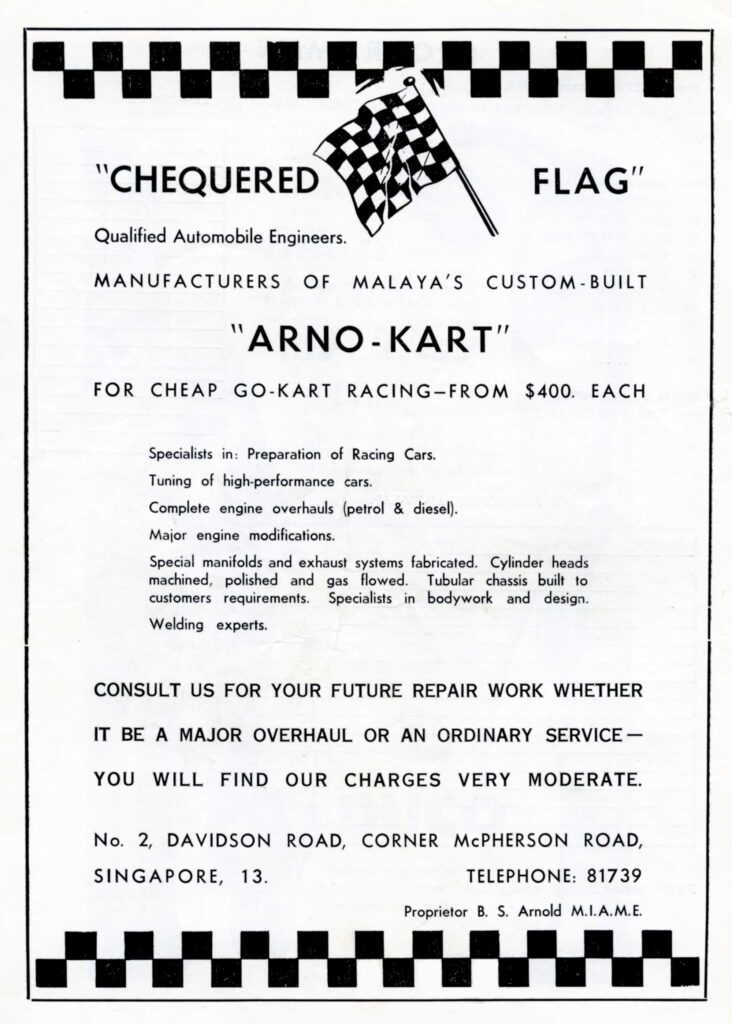
Bernard Arnold’s Arno-Kart advert in the 1960 Johore Grand Prix program. Bernard Arnold has to be credited for building/making the first Go-Kart in Singapore.
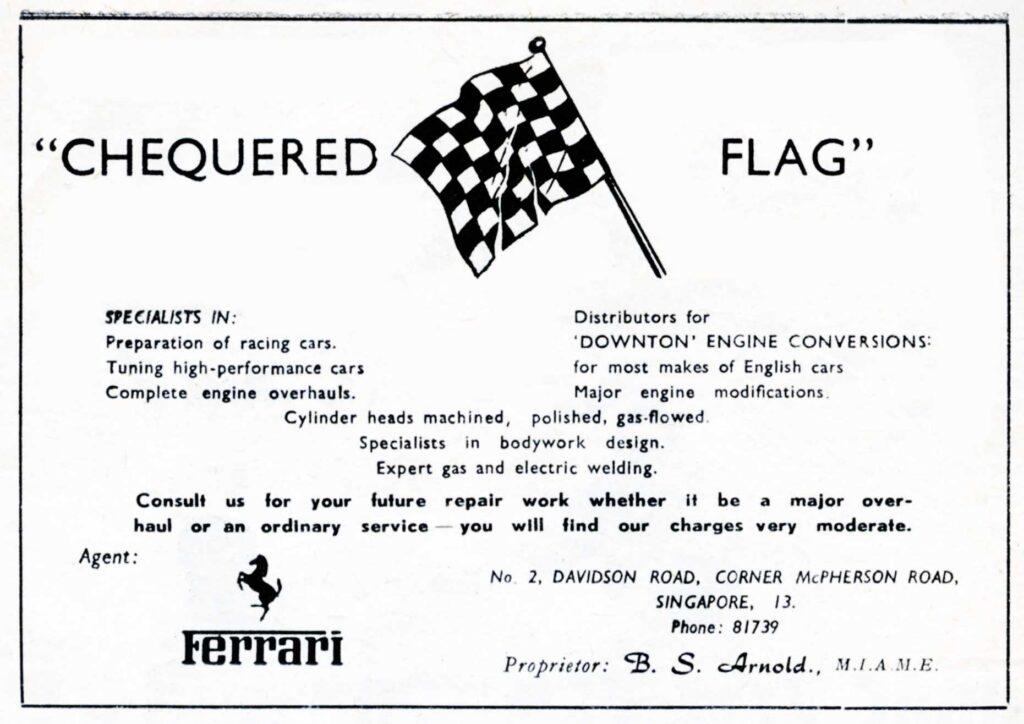
Bernard Arnold’s 1961 advert for his Chequered Flag Garage in Singapore. The company were Ferrari distributors for Singapore and Malaya.
In December 1959 Arnold was also at the forefront of the newly-formed Singapore Go-Kart Club, its founder member. In fact, Arnold had constructed a Go-Kart for the local racing community, built at his Davidson Road garage. He called it the “Arno-Kart” – For cheap Go-Kart racing 36. Only the two-stroke motor, a 200cc Villiers, and tyres, were not produced at his garage. At $400 a pop, he was competing against American made karts. Whether Arnold’s Singapore Go-Kart Club survived is not known, suffice it to say that a Singapore Karting Club was formed in December 1960.
Time was of the essence if Arnold wanted to take part in the 1960 Johore Coronation Grand Prix. Frantic activity at Chequered Flag Engineering ensured that the car was completed in time, but the poor Bristol BS4 engine was tired and feeling the effects of its tropical existence. Still, he won Johore Grand Prix support Race 11, for Grand Prix cars 1,501-2,000cc, beating his usual rival Chia Eng Quee (Rover Special) after the latter’s engine lost power on lap 4! Arnold won by just under 8 seconds with Stanley Leong third in his #28 S.L. Ferrari (ex-MGA). Chia set fastest lap – 2 min 00.5 sec. See JOHORE GRAND PRIX – Part 2: 1960-1963
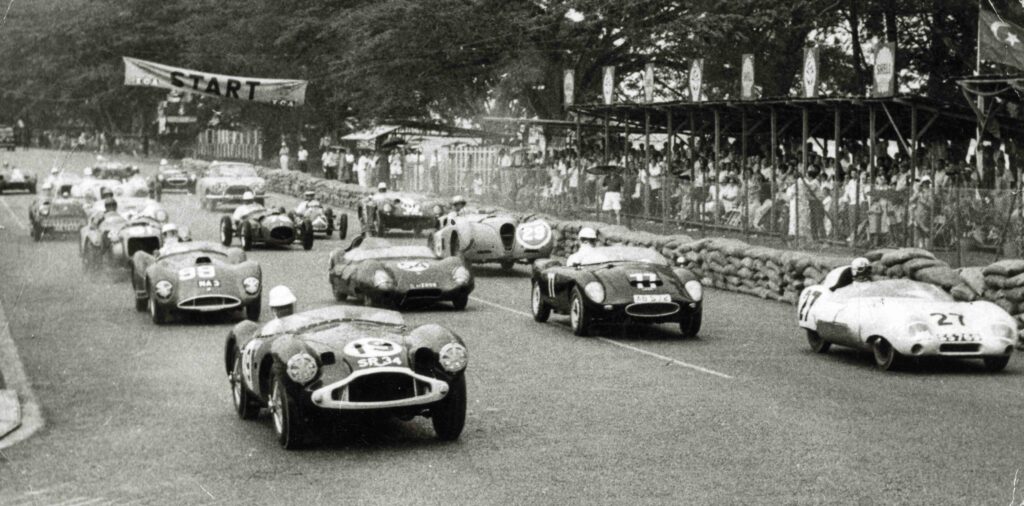
The start of the 1960 Johore Coronation Grand Prix. The #99 Warrior Bristol is behind Chan Lye Choon and his Aston Martin DB3S (#19). See JOHORE GRAND PRIX – Part 2: 1960-1963
In the main Grand Prix Arnold managed to move up to second in lap 2 (it was a wet start), in close pursuit of Bill Wyllie’s Auto Union 1000 RS. By lap 5 however, the Warrior’s challenge was starting to wane. Arnold and the Warrior challenge ended after 32 of the 70 laps.
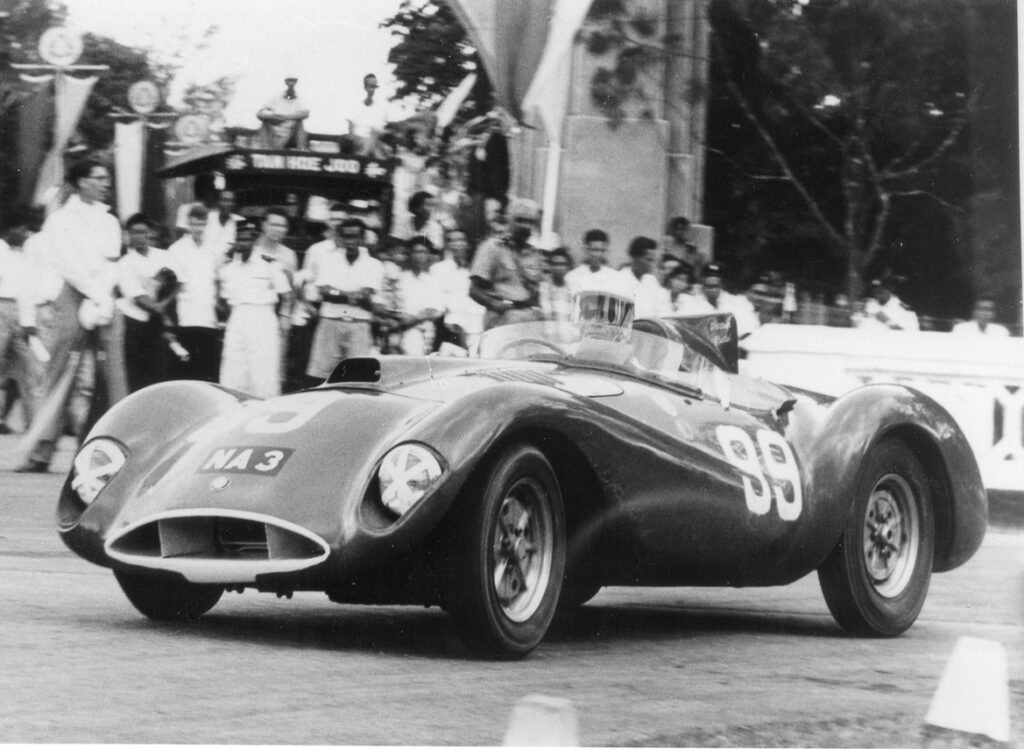
The Warrior Bristol (with remodelled front end with headlight) in action at the 1960 Johore Coronation Grand Prix, the last occasion the car would run with the 1991cc Bristol BS4 motor (the exhaust pipes exited on the car’s right). Shortly after Johore, Arnold installed what was said to have been a special straight-six Jaguar motor, thus turning the Warrior Bristol into the Cooper Jaguar. There couldn’t have been much of anything Cooper in that car. See JOHORE GRAND PRIX – Part 2: 1960-1963
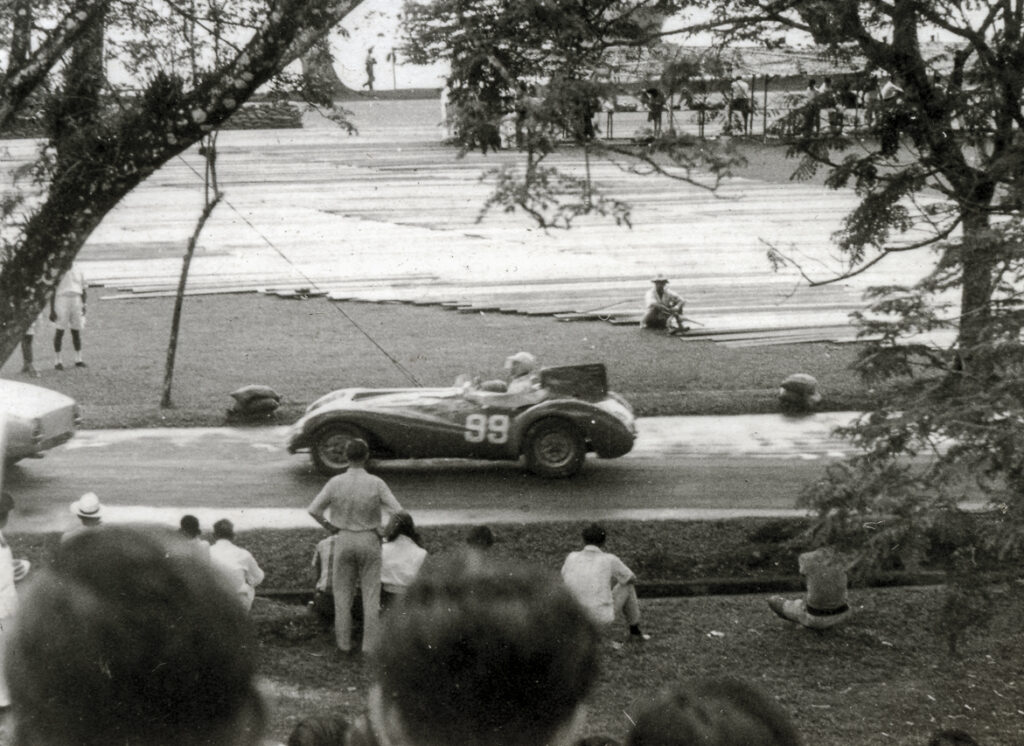
The Warrior Bristol on the short approach to Court House Corner in the 1960 Johore Coronation Grand Prix. The Start straight can be seen in the background.
SMOKE & MIRRORS
After the 1960 Johore Coronation Grand Prix, Arnold’s Chequered Flag Engineering, which touted itself as Jaguar specialists as well, replaced the Bristol motor with a Jaguar twin-cam 2.4-litre 37 lump from Jaguar’s new sporty compact saloon range [Mk1 – 1956-1960]. Little is known of the specifications of the car following the demise of the Bristol motor although there was talk that the replacement was a very special Jaguar motor (see below for sales advertisements of the car with Jaguar “D” Type head). The Bristol couldn’t have been an easy motor for the local knowledgebase to handle – what with more pushrods than wheel lugs and with triple twin-choke downdraft Solexs. This was dark arts stuff of shamins, bomohs and pawangs in Singapore, incantations uttered in whisper in Malay, Hokkien or Teochew dialects and paper money burnt as offering to the gods of speed. Shoehorning the Jaguar motor into a chassis of unknown origin must have meant a great deal of head scratching for the local mechanics tasked with the job, plus endless hours of road testing and reworking until Arnold could safely use the car at speed events. Sure, Lim Peng Han, Chia Eng Quee and Tan Ah Bee had all gone down that route before, but they were working primarily with ladder frames, not birdcages.
Back to that Jaguar motor. Did Arnold manage to procure one of the three-litre engines that Jaguar had developed and tested in December 1957 (where it recorded 254bhp at 6300rpm)? Was it the stroked Ecurie Ecosse unit, also using the 2.4-litre block? Or was it a 2.4-litre block with a B-type head and D-type cams and some porting and polishing?
Jaguar’s experimental engine was 2,986.6cc (83 x 92mm bore/stroke) while the Scottish team’s unit was 2,954cc (also developed and tested in Coventry). As an aside, the compact saloon’s 2.4-litre engine (2,483cc) had a bore/stroke of 83 x 76.5mm), while the 3.4-litre 38 XK motor had a bore/stroke of 83 x 106mm). Jaguar called their 3-litre it a “Works Conversion”, suggesting the head was the key (called the 35/40 head – 35 degree intakes, 40 degree exhaust valves).
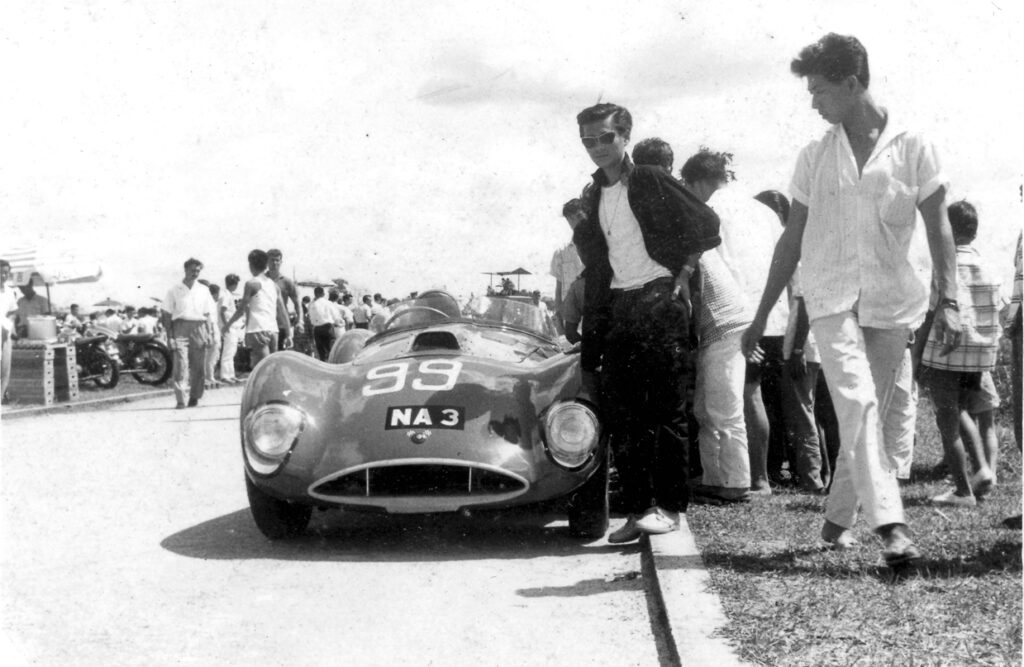
A post engine transplant photo of the now-Cooper Jaguar at one of the club events in Singapore during the early 1960s.
Whatever the case, Arnold procured an engine with a B-type head, D-type cams and some well-fabricated intakes. The front end would certainly have had to be stiffened to cope with the additional weight of the Jaguar motor and triple Webers. Whether he had it as a dry- or wet-sumped motor during Arnold’s ownership is not known (and unlikely) but by the time the car arrived in Australia in 1971, it wasn’t dry-sumped, nor did it have an oil filter housing 39!
Rightly or wrongly, Arnold’s car was christened the Cooper Jaguar, which made sense to everyone around, seeing that it was no longer Bristol-engined nor did it look like anything like the old Warrior.
Everyone wanted to see how the Cooper Jaguar would perform at the Dunlop Gap Hill Climb on 8 May 1960 but other interests got in the way – Arnold had sustained injuries in a karting accident prior to the Gap. Was Arnold at the 3 July 1960 watershed event – the inaugural sprint at the 1.4-mile Old Upper Thomson Road course? He doesn’t feature in the results. We know that the Cooper Jaguar made its maiden appearance at the Dunlop Gap Hill Climb on 9 October 1960 – which everyone recalled was a very loud car, but a lot slower than Yong Nam Kee’s hot Austin Healey 100-4. Runner-up in Class was as good as it got for Arnold and the Cooper Jaguar. The owner had a lot more work to do.
It was strange that Arnold missed the second Old Upper Thomson Road Sprint held on 27 November 1960. Perhaps he was entered but did not in results. We see most of the big/regular names entered – Bruce Macrae-Smith him his Scuderia Tizwoz 498cc Cooper, Jimmy Milne and Chan Lye Choon in the Chan Cooper JAP, Tan Ah Bee/Tony Huggett in the Lotus Eleven Climax, Lim Peng Han in his Lim Special, Yong Nam Kee in his Healey 100-4, Chia Eng Quee in his Rover Special, Capt. Leslie Howell in his Turner Climax, even R.J. Le Sbirel in a 356 Porsche.
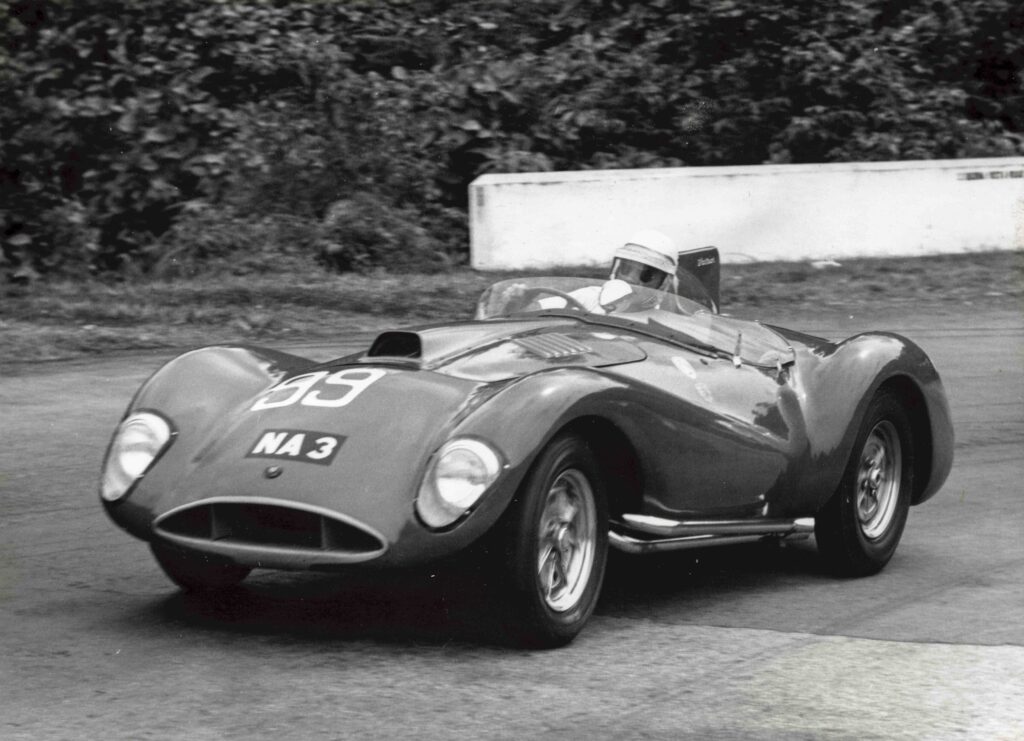
Arnold’s Cooper Jaguar was always neatly turned out and the body modifications looked smartly executed. Everything was polished to a shine – from Cooper magnesium wheels to the exhaust pipes from the Jaguar motor. It must have created a real racket without a silencer box in place.
Early the next year, the Forces Motoring Club held its Sembawang Circuit meeting (29 January 1961). Again there was no mention of Arnold or the Cooper Jaguar at this circuit event. Perhaps the memories of destruction at past Sembawang events made Arnold acutely aware of how treacherous the circuit had been for the car? Still, attendance was good with all the regulars there – Chan and his Milne in the little Cooper JAP, Peter Cowling in his Austin Healey 100-6, Yong Nam Kee in his 100-4, even Eric Cooper, who would late become quite intimate with the Cooper Jaguar, in his modified Austin Healey Sprite (the Cooper Special).
Arnold missed the Kledang Hill Climb on 12 February 1961, though most of the entrants were from upcountry – Peter Todd, Peter Cowling, Perak planter Spencer MacDonald (Porsche Super 90), Bill Davis, Douglas Earp etc.
The Old Upper Thomson Road Sprint was held on 26 February 1961, the third time this sprint was run though the course was now 60 yards longer, which meant that the old records were no longer valid. Arnold appears in the results with a second place finish in the Sports Cars 2,700cc and Over class, behind Yong Nam Kee’s blisteringly fast 61.44 sec. time set in his Healey 100-4.
In April 1961, Arnold’s Chequered Flag Engineering were offering Downton conversions for Minis, Rileys, Austin A40/50s, Triumph Heralds, Renault Dauphines and MG Magnettes. In May the Chequered Flag Engineering adverts offered modifications for the upcoming Johore Grand Prix “Backed by 30 years Racing Experience.” 40 By now, the island had a couple of such suppliers, the other being airman Francis Jan Bussell, whose moonlighting business called Torque Shop Singapore, offered Alexander conversions and camshafts for Mini, Austin, Ford, and Triumphs etc.. It too was short lived because Bussell upped and left for Kuala Lumpur to start up his own aviation business (and Torque Shop at Jalan Sungei Besi in Kuala Lumpur).
At the Forces Motoring Club’s Sprint at the Sembawang RASC Nursery Circuit on 16 April 1961 Arnold had yet another of those unfortunate encounters with the kerbs, which forced his withdrawal. No racing car has ever had or will ever be that intimate with the roadside kerbs of the Sembawang RASC Nursery Circuit. It is probably safe to assume that this gave him an opportunity to develop the car further – perhaps with front disc brakes (from a late series MGA).
NATURAL HABITAT
NATURAL HABITAT: The biggest event of the first half of the year was the Johore Grand Prix, held 24-25 June 1961. Arnold wouldn’t have missed this for the world and the car was entered for the support race as well as the 70-lap Grand Prix proper. If a little two-stroke Auto Union could win in Johore (1960), anyone with a reliable racing car could pull it off.
The Sports Cars support race (Race 5) combined the 1,001-1,100cc cars with the 2,001-3,000cc cars, meaning the Arnold’s car (listed with 2,398cc motor, though the programs were notoriously unreliable) was in the same race as Capt. Leslie F. Howell’s Turner Climax and Tony Huggett’s Lotus Eleven Le Mans Climax. The cars in the 2,001cc and over class were Peter G. Cowling (#8 2,995cc Austin Healey 100-6), Doc Marshall (#29 Zephyr Sports), A.A. McLaren (#70 2,660cc Austin Healey), M.J.W. Wood (#78 2,660cc Austin Healey), 24-year-old Army officer Dominic Salwey Barrington-Browne 41 (#80 Austin Healey 100-4), Dickie Clinkard (#85 2,912cc Ruddspeed Austin Healey 3000 42), Peter M. Todd (#21 Jaguar XK140 FHC 43), Freddie Johns (#24 Jaguar XK140) and Paul J. Gibbs Pancheri (#69 4 ½-litre Bentley).
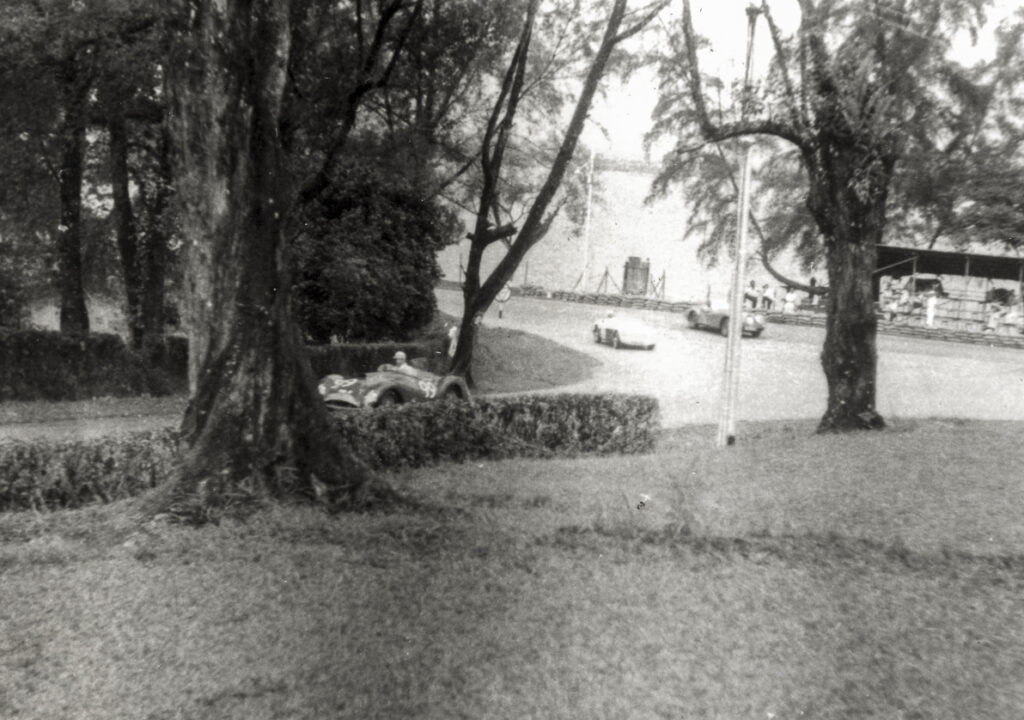
The Cooper Jaguar exits Zoo Corner during the 1961 Johore Grand Prix.
In the 15-lap race, the fancied Cooper Jaguar finished third overall – behind Huggett’s Lotus Eleven Le Mans Climax and Dick Clinkard’s Ruddspeed Healey 3000. He was placed second, behind Clinkard, but ahead of Doc Marshall and his Zephyr Sports, in the 2001-3000cc class. The Cooper Jaguar should easily have beaten the heavier Austin Healey sports cars but this was all new territory for Arnold and his Chequered Flag Engineering team as they came to grips with the tube-framed chassis of the old Warrior, its newly installed Jaguar straight-six motor and the lack of circuit a proper circuit race in the jungles of Malaya and Singapore.
In the Grand Prix Arnold had the great misfortune of having a bungled pit stop, which once more gave him newspaper coverage. The Straits Times lapped it up with a story titled: “Water Puts Arnold Out of GP.” 44 Arnold revealed that he pulled in for what must have been an unplanned splash and dash on lap 57 of 70. In haste, instead of filling the tank with petrol, his mechanics bungled the stop and filled the tank with three gallons (13.6 litres) of water. He was in second place at the time, chasing eventual winner Chan Lye Choon (Lola Mk1 FWE Climax). Arnold’s race was over. We shall never know what really happened that day. In any case, the 2.4-litre Jaguar engine was ready for September’s inaugural Singapore Grand Prix.
It had taken much effort and a whole lot of lobbying before a proper circuit race in Singapore was held. Freddy Pope and his Singapore Motor Club team pulled it off in September 1961 and the club organised (with Ministry of Culture support) the Orient Year Grand Prix on 16-17 September 1961 [see 60 YEARS AGO: THE ORIENT YEAR GRAND PRIX]. Little did Pope and the die-hard enthusiasts know that the Formula Libre Grand Prix would actually continue uninterrupted for 13 years, with the last one held in April 1973.
Arnold’s sports car permitted him to enter the Cooper Jaguar in one of support races as well and so the 2,460cc (the capacity listed in the race program), race number 99, showed up on the grid for the Sports Cars 15 lap race (entered in the 2,001-3,000cc class). Arnold finished behind Dick Clinkard (Ruddspeed Healey 100-6) once again, with Dominic Barrington-Browne third in his 2,661cc Healey 100-4. Overall however, the Sports Car race was a battle between Robert Lee’s Rover Special and Barry Swann’s AC Ace. Swann’s AC, with its fully independent suspension, had the initial pulling power to take an early lead. A great deal of showmanship had already taken place in Friday’s practice with Robert Lee muscling his ex-Chia Eng Quee Rover Special around the course. Lee would use the same tactics to try to unnerve Swann in the race. With Stanley Leong’s Ferratus giving no end of engine trouble, it was left to Lee and the Rover Special to win ahead of Swann, Dick Clinkard’s Ruddspeed Healey and Arnold’s Cooper Jaguar. Kelly’s Warwick GT did remarkably well to beat Mike Cook’s “Laurence Healey” Triumph TR3 and Dominic Barrington-Browne’s Healey 100-4. In the 60-lap Grand Prix, Arnold finished fifth overall, behind Ian Barnwell (#62 Aston Martin DB3S), Saw Kim Thiat (#33 Lotus Eleven), Dick Clinkard (#49 Ruddspeed Healey), Tan Ah Bee (#29, the ex-Doc Marshall 1.6-litre Zephyr Sports). Eric Cooper finished sixth (#24 Austin Healey Sprite) and Bruce MacRae-Smith finished seventh (#51 Austin Healey 3000).
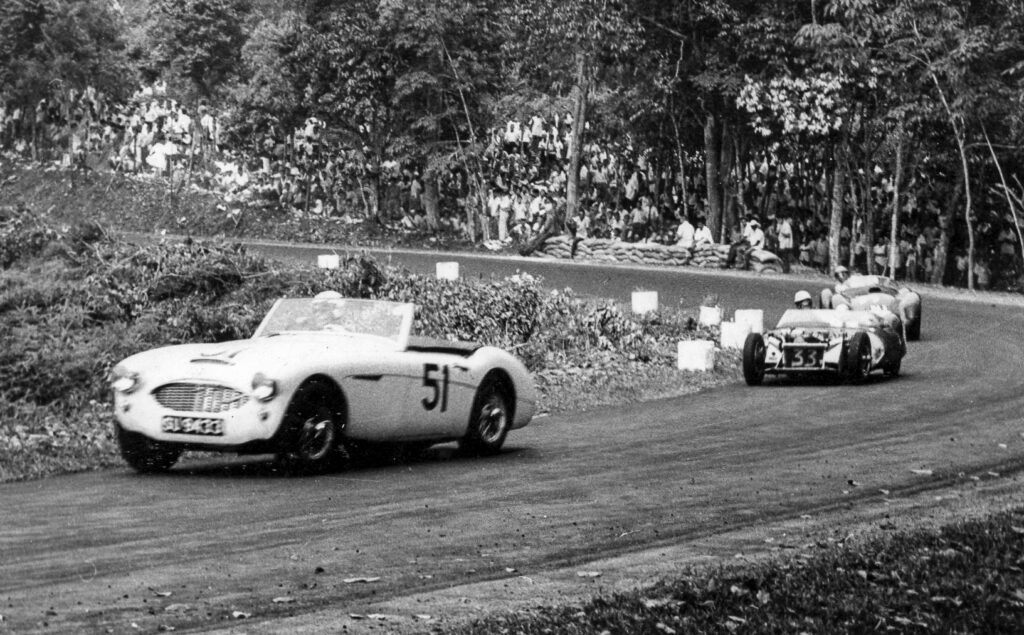
Bernard Arnold chases Saw Kim Thiat’s overheating #33 Lotus Eleven FWA Climax during the latter stages of the 1961 Singapore Grand Prix. In front (possibly being lapped) is Bruce MacRae-Smith in his road registered (SU9433) Austin Healey 3000.
The Cooper Jaguar was at the Gap Hill Climb in Singapore on 22 October 1961, entered in the 2,700cc and Under Sports Cars class. Arnold finished third, behind Yong Nam Kee in his Austin Healey 100-4, and Tan Ah Bee in the constantly evolving Zephyr Special. The Cooper Jaguar was unplaced in the Sports Cars Unlimited class. There weren’t satisfactory results for a Sports Car that ought to have easily beaten the Austin Healey 100-4 and any and all of the local specials. The 2.4-litre Jaguar motor needed to be tuned for local conditions – including the oppressive heat/torrential rains that were part and parcel of racing in the tropics. Where was Arnold able to find a skilled tuner for those triple twin-choke Webers. Certainly no one in the region had ever seen a 2.4-litre Jaguar with triple side draught Webers, let alone triple downdraft Solex carbs.
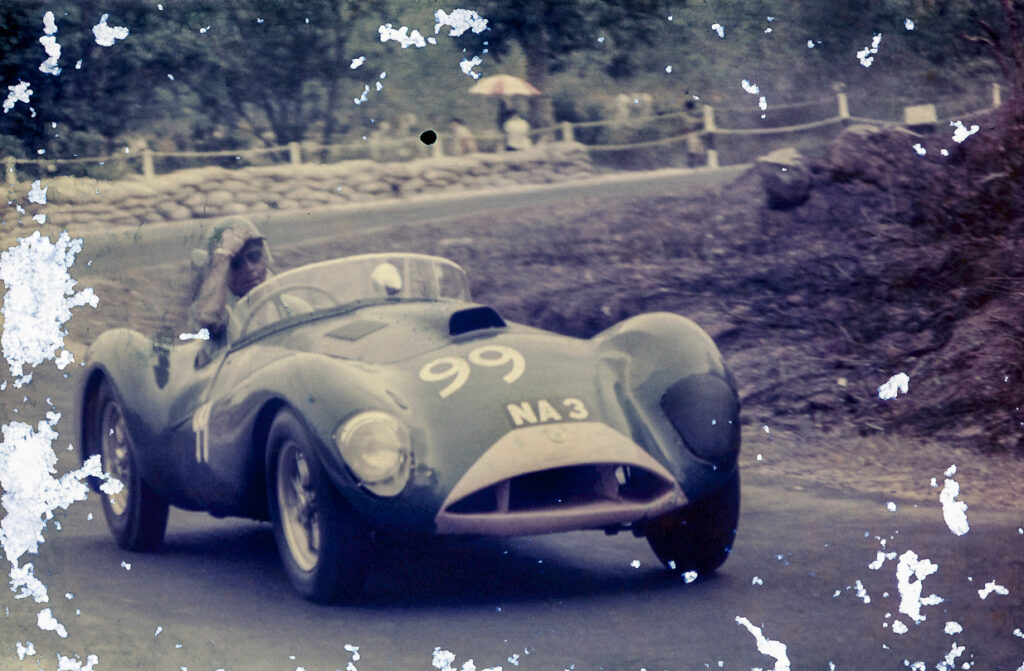
A rare colour photo of Bernard Arnold in his Cooper Jaguar, inaugural Singapore Grand Prix.
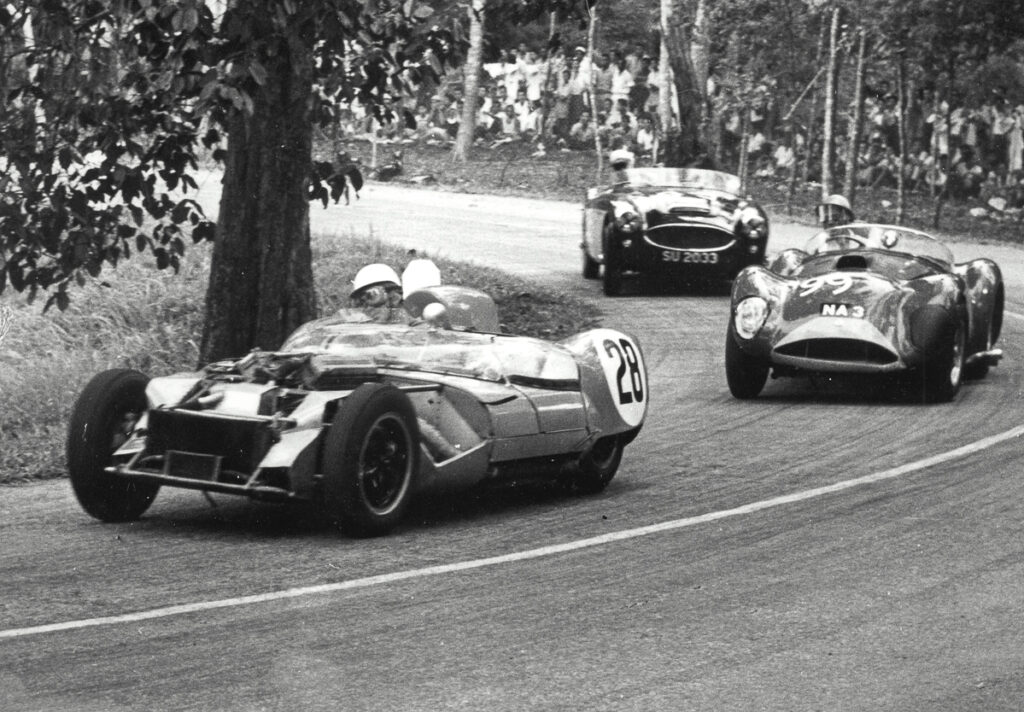
Arnold chases Stanley Leong in the Lotus 15-Ferrari (aka the Ferratus) during the 1961 Singapore Grand Prix. Behind Arnold Dick Clinkard’s #49 Ruddspeed 3000 Mk1 Healey (road registration SU2033).
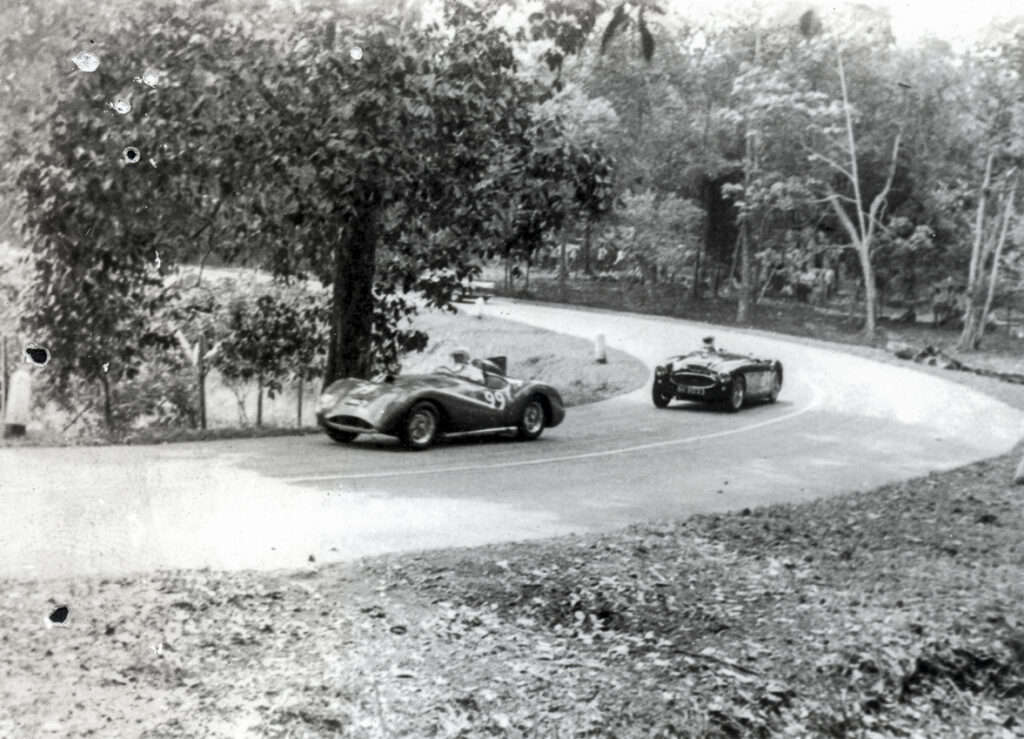
Another photo of the Cooper Jaguar attacking Devils Bend during the 1961 Singapore Grand Prix. Behind Arnold is Dick Clinkard in his Ruddspeed Healey.
Meanwhile, Chequered Flag Engineering Works were offering much sought-after Downton intakes and exhaust manifold conversions for Austin and Morris Minis, Rileys, Austin A40s and 50s, Triumph Heralds, MG Magnettes and Renault Dauphines. It was a tiny market but at least the local enthusiasts had an outlet setting such goodies (until Wong Peng Hong opened his new Newton Enterprises showroom in December 1965 at 255 Middle Road, Singapore – specialising in BMC and Ford goodies 45). The company were listed as specialists in race car preparation, gas flowing, head machining and experts in gas and electric welding 46.
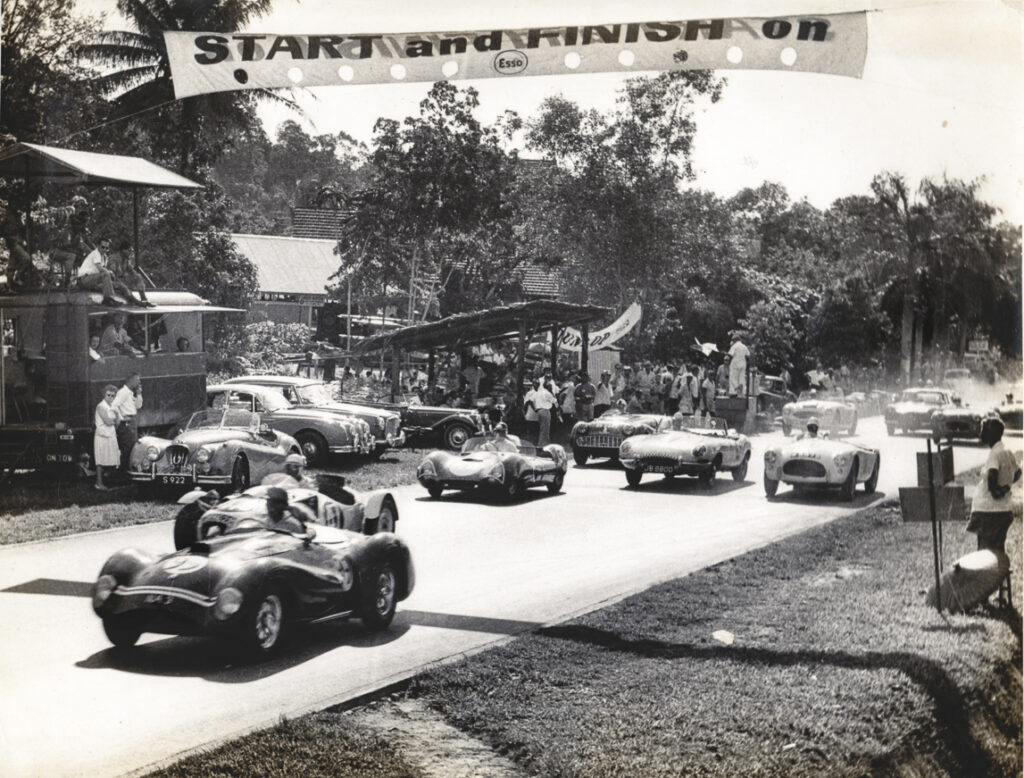
Arnold in his blue with double white band Ecurie Ecosse D-Type-livery-looking Cooper Jaguar at the front of the grid as the cars take off for the Sports Cars support race (1600cc and over), 1962 Malaysia Grand Prix in Singapore. Behind Arnold is Robert Lee his Robert Lee Special (#47), Peter Heath in his Lotus 15 Climax (#54), Freddie Johns in his Jaguar E-Type (#36) and Lam Theng Pew in the ex-Barry Swann AC Ace (#87). Arnold finished second overall (and first in the 2001cc and Over class), behind Peter Heath in the Lotus 15 Climax.
Arnold was also active in the Singapore Motor Club and sat on the committee for the 1962 season (the elections were always held in February or March) when Sir James Lockerbie sat as President. Whether Arnold had an inkling of the extent of his illness in 1962 is not known. Suffice it to say that he was forced to wind down his business by the middle of the following year, quite suddenly.
The Forces Motoring Club’s New Year Sprint at the Sembawang RASC Nursery Circuit was held on 14 January 1962. Arnold was entered in the Sport Cars 2001cc and Over class – and bagged first (probably because there were no other entries in his class). He was not placed in the Sports Cars Unlimited class. Shortly after, Arnold placed an advert for the sale of the car – listed as a “Cooper Jaguar, Fastest car in Malaya! 1961 “D” Type Engine, Weight 1,250 lbs. 6 Weber Carburettors, Disc Brakes, 440 BHP/Per Ton. 0-100 MPH in 12 Secs.! Cost $34,000. Open to any Examination. Guaranteed to finish any 300 mile Grand Prix Race. Sensible enquiries only. Ring 81739.” 47 This therefore dates the front-end modifications (disc brakes etc.) to Arnold’s ownership and not later on during James Watkins’ ownership.
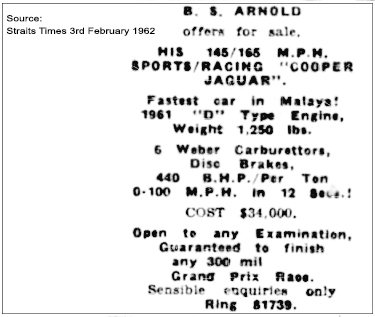
Bernard Arnold’s very revealing advert for the sale of the Cooper Jaguar appeared in the Straits Times of 3 February 1962. The car did not sell and Arnold entered it in the 1962 Grand Prix in Singapore in April that year.
We don’t know if Arnold prepared for the 1962 Grand Prix in Singapore by taking part in the 19 March 1962 RAF Tengah Kilo Sprint that was organised by Seletar Auto Club. FTD at Tengah was set by Lim Peng Han in his Lim Special. But we do know that Arnold and his car were at Upper Thomson Road in April 1962, ready for the Malaysia Grand Prix in Singapore.
The Cooper Jaguar now had a blue paint job with Ecurie Ecosse livery and Arnold was optimistic that the Jaguar motor would deliver the goods necessary to win the 1962 Malaysia Grand Prix in Singapore over Easter 1962. The car was entered in the Sports & GT race as well as in the 60-lap Grand Prix.
In the Sports & GT cars 1,600cc and Over class Arnold and the #99 Cooper Jaguar (capacity listed as 2,441cc) finish an impressive second, behind Bangkok-based Peter Heath in a Lotus 15 Climax but ahead of Lam Theng Pew in the 1971cc AC Bristol. Heath of course set fastest time in that race. Arnold therefore also bagged the class win (2001cc and Above), beating Freddie Johns and his #36 E-Type and winning an Esso award of $100 and a trophy. In the Grand Prix, it appears that Arnold and his Cooper Jaguar retired before the half way mark.
The Singapore Motor Club’s National Day Commemoration Sprint was held at Old Upper Thomson Road on 24 June 1962. As the course distance had been altered, all previous records set before 24 June 1962 no longer applied. Arnold doesn’t appear in the results. He entered the car in the 5 August 1962 Gap Hill Climb but his results are not known.
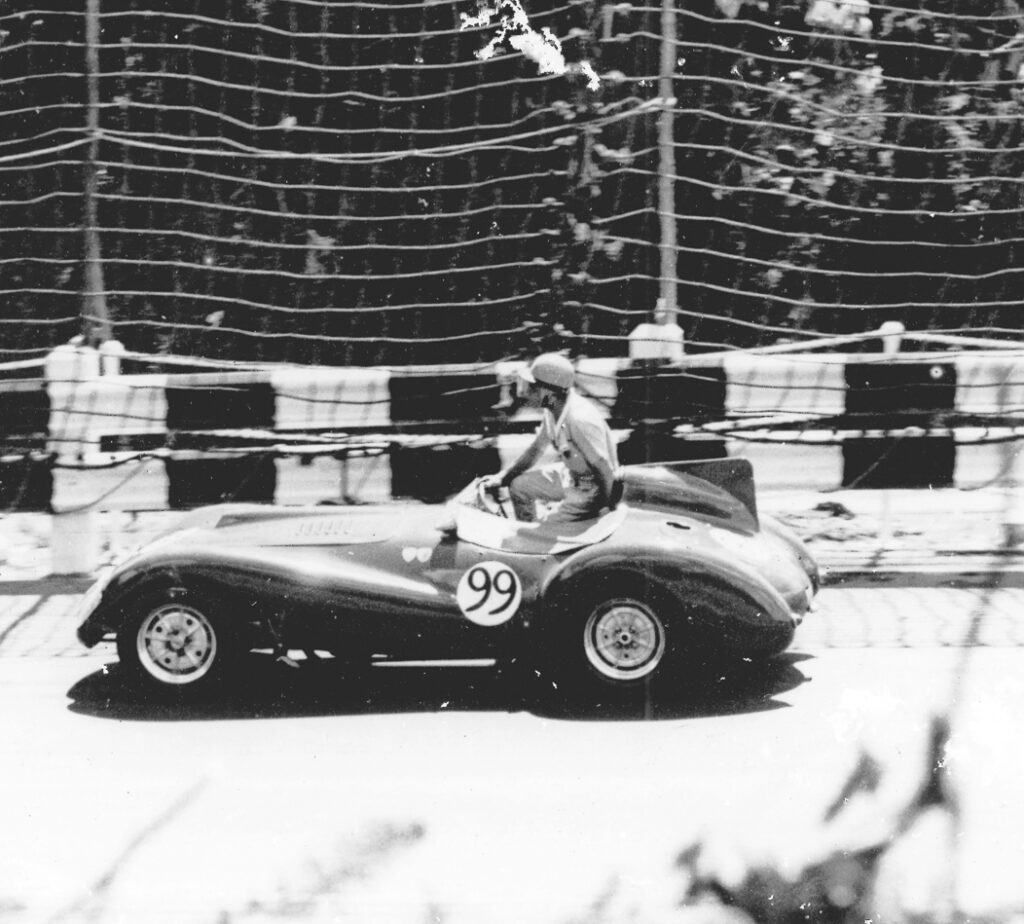
Retirement for Bernard Arnold and his Cooper Jaguar in the 1962 Singapore Grand Prix.
Later in 1962 Arnold entered the car in the RAF Seletar Auto Club’s Quarter-Mile Sprint [23 September 1962]. He finished second in the Racing Cars Unlimited class, beaten by Lim Peng Han in the Lim Special (by 1.52 seconds!). Lim set FTD in the event. Arnold however beat Chai Eng Quee in the Eng Quee Special. In the Sports Cars 3000cc and Under class, Arnold beat Col. Bunny Burnett in a Daimler SP250 (by just over 3 seconds!). Arnold also won the Sports Cars Unlimited class, beating L.J. Cole and Peter Leonard, both in Lotus Sevens. Arnold appears to have raced Capt. Leslie F. Howell’s MkII Turner Climax in the 1300cc and Under Sports Cars class, which he won.
FINAL FLING
FINAL FLING: Bernard Arnold’s preparations for the 1963 Grand Prix in Singapore (over Easter) consisted of the Old Upper Thomson Road Sprint on 10 February 1963 and the 17 March 1963 RAF Seletar Auto Club’s Quarter-Mile Sprint. But was the something amiss with his health? The racing suggested otherwise.
At the RAF Seletar Auto Club’s Quarter-Mile sprint Arnold won his Class and returned with two trophies – for his Sports Cars Class (3,000cc and Under) and Sports Cars Unlimited class.
Amidst merger tensions between Singapore and Malaysia, the Cooper Jaguar arrived at Upper Thomson Road on Friday 12 April 1963 with new light blue paint scheme for the 1963 Malaysia Grand Prix (Singapore). Gone was the 1962 Ecurie Ecosse livery. Arnold entered the Cooper Jaguar in Race 7, for Sports & GT Cars 2,001-3,000cc (10 laps), and in the 60-lap Grand Prix. He was also entered in two other support races – the 5-lap Vintage and PVT Handicap race in Danny Needham’s 48 1926 Amilcar C4 Suzette; and the 10-lap Saloon & Tourers race in a Ford Cortina 49 (1,151-1,600cc class).
Arnold won his class in Race 7 for Sports & GT Cars 2,001-3,000cc 50 and finished third overall in the 10-lap race. He qualified for the Grand Prix in the car but was unplaced at the end. He was unplaced in the Vintage Handicap race in the Amilcar as well as in the 10-lap Saloon & Tourers race in the Ford Cortina.
The Malaysia Grand Prix over Easter in Singapore was the last motor race Bernard Sydney Arnold entered. In July two adverts appeared on the same day in the same issue of the Straits Times (2 July 1963, pg. 17). The first advert offered all equipment and stock of Chequered Flag, Engineering Works at 2 Davidson Road. These included carburettor conversions, seat belts, steering wheels etc.. The reason for this was a rather shocking: “Owing to ill health.” The second advert was for the Cooper Jaguar: “150 M.P.H. 0-100 M.P.H. 12 Secs. B.S. Arnold’s Cooper Jaguar 240 B.H.P. 1961 “D” type engine, 6 Weber Carburettors, Disc Brakes 51, Ready for seasons Racing, finished every race entered. Can win Johore G.P. in a young mans hands. $10,000. Ring 81739 or 87948.”
Arnold returned to England for treatment in early July but tragically succumbed to cancer on Friday 13th September that year, just 49 years old. The Cooper Jaguar remained in Singapore.
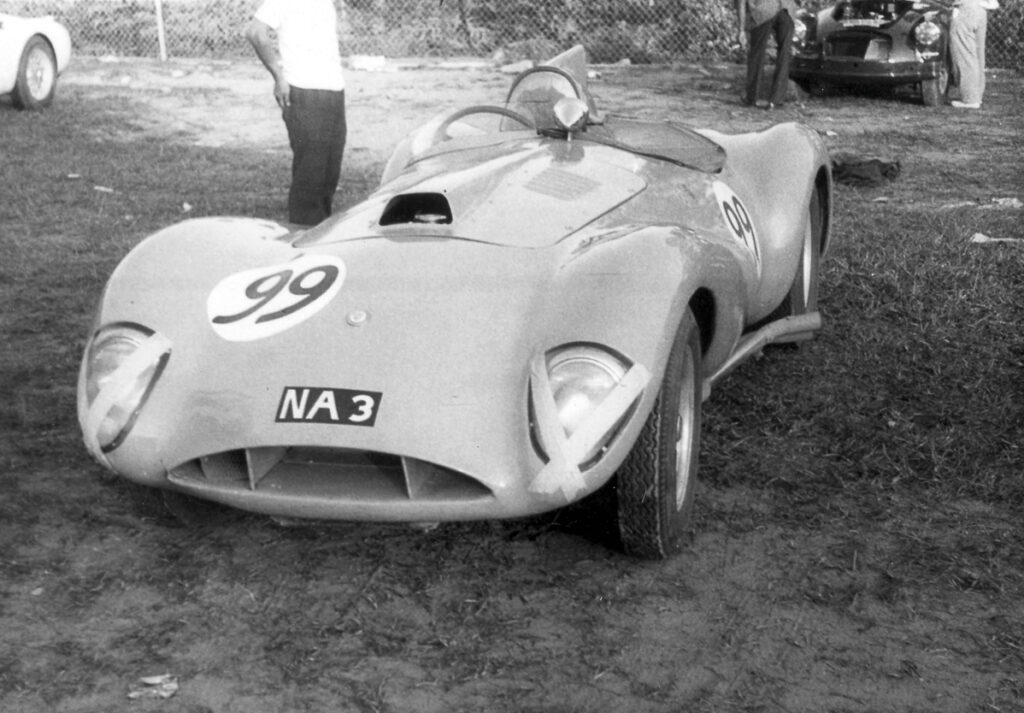
1963 Singapore Grand Prix with the neatly redesigned front end, removal of the full width wraparound windscreen and new paintwork. Additional front vents to aid in cooling would come later on.
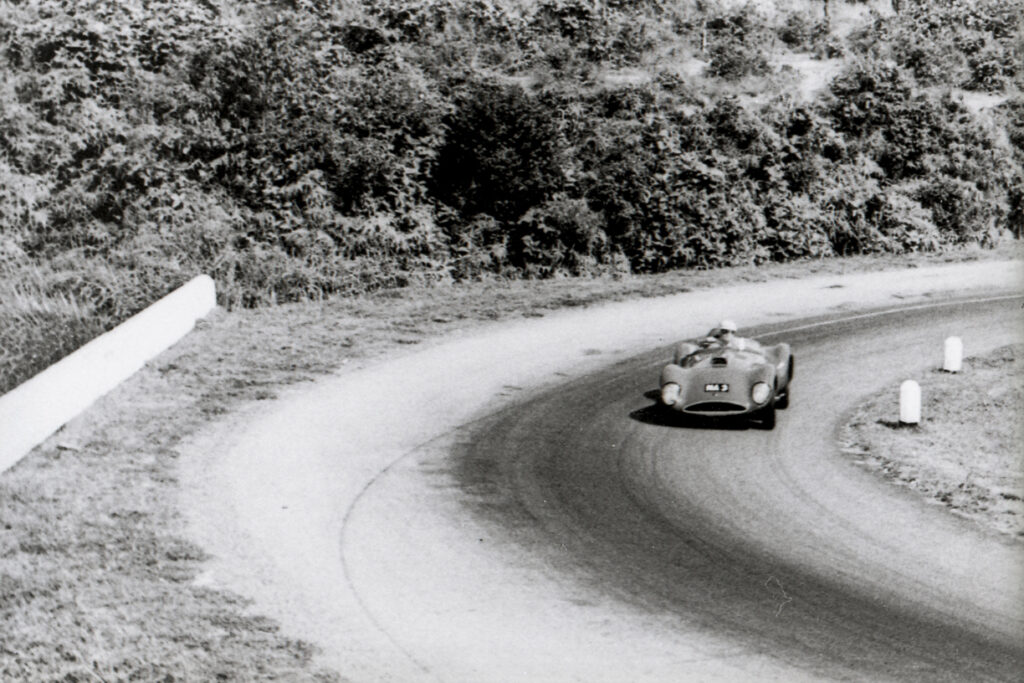
Bernard Arnold tackles the hairpin at the Gap in Singapore, circa 1963.
His record of 151 first positions, 50 second places and 25 third positions (according to a Singapore reporter for the Straits Times) in the Warrior Bristol/Cooper Jaguar reflects how active he was in Malaya and Singapore.
NEW HOME
NEW HOME: Following Arnold’s departure, a second advert appeared (Straits Times 12 October 1963, pg. 13) offering the Cooper Jaguar for sale “The Ex-Bernard Arnold 2440cc Cooper-Jaguar is for sale.” The seller listed nothing but a Straits Times classified box number. Mr. Farnsworth of 15 Second Avenue, Singapore, advertised the car on 11 January 1964 in Singapore 52. “Ex Bernard Arnold 2440cc Cooper Jaguar 240bhp ‘D’ type head, six Weber Carbs: In racing condition.” 53
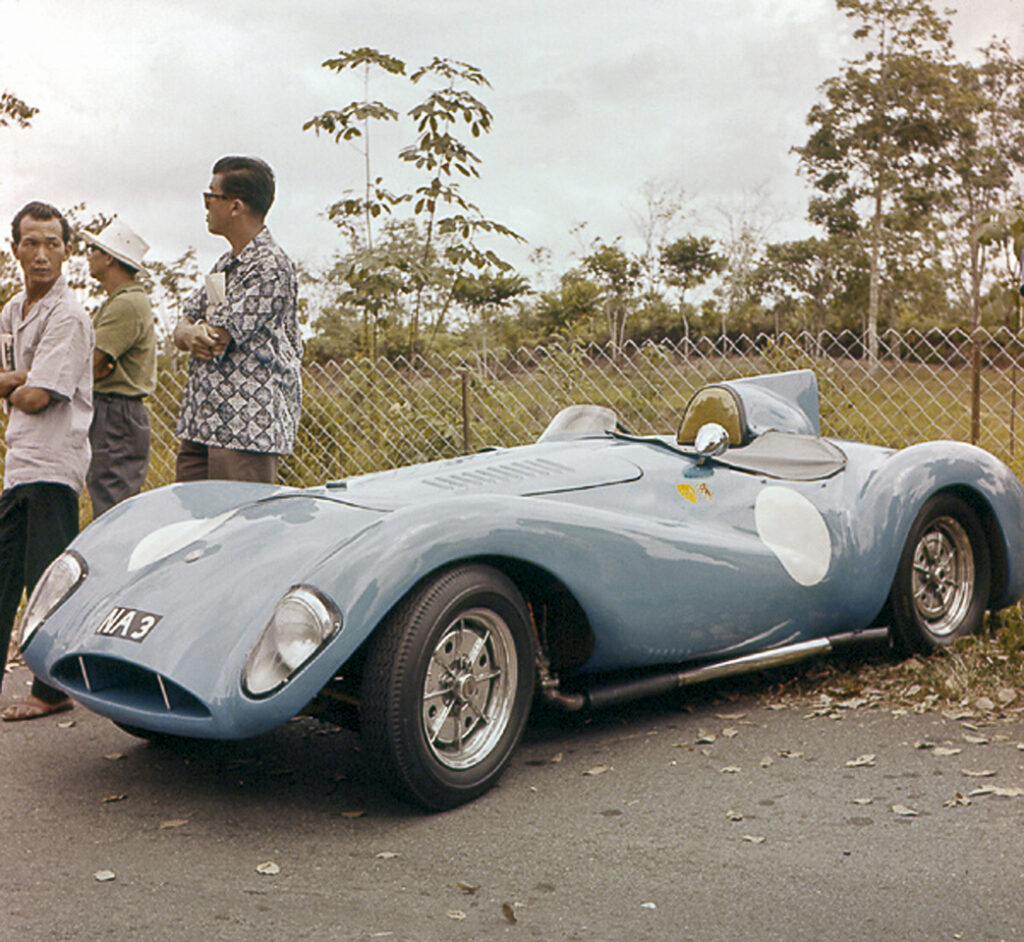
The 2.4-litre Jaguar headers exited from the left of the cylinder head while those of the Bristol BS4’s exited from the right. This photo is undated but is probably from a sprint or hill climb event in Singapore in 1963. Cooling ducts would come later.
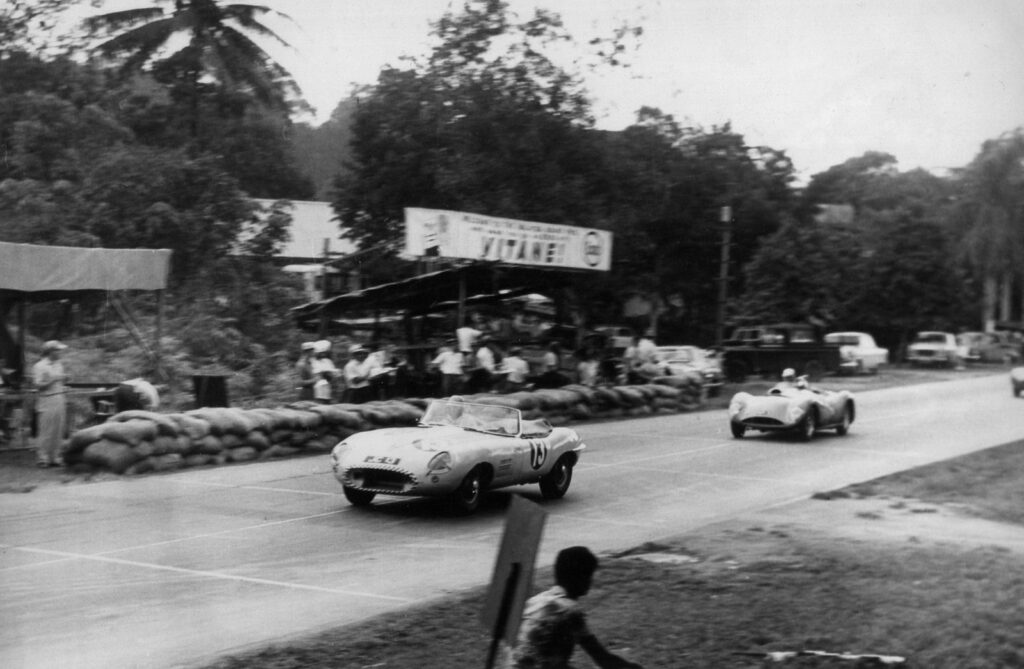
Two Jaguar-engined cars on Upper Thomson Road during the 1963 Grand Prix in Singapore. The photo can be dated by studying the #13 Jaguar E-Type. The car had had a makeover (new lightweight bonnet and doors) following an accident in the Grand Prix in 1962 (plus a road registration number change from JB8800 to JC13).
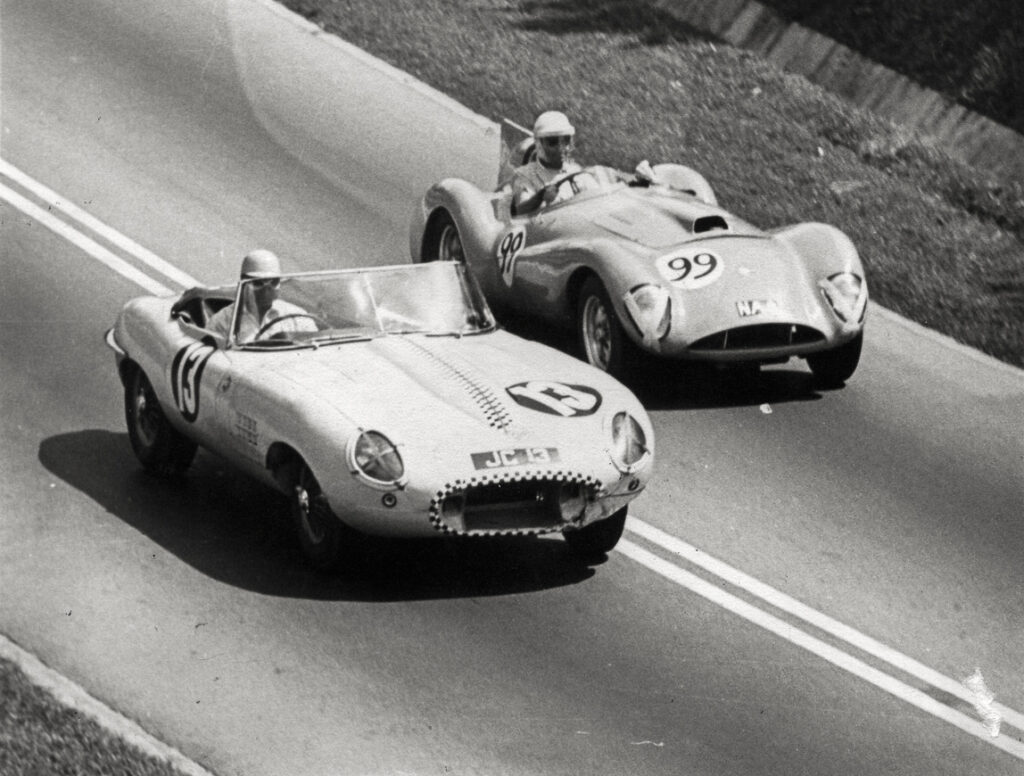
Arnold 2.4-litre battles it out with Freddie Johns’ 3.8-litre E-Type on the Upper Thomson Mile during the Grand Prix in Singapore in 1963. This would be Bernard Arnold’s last Grand Prix race in the Cooper Jaguar.
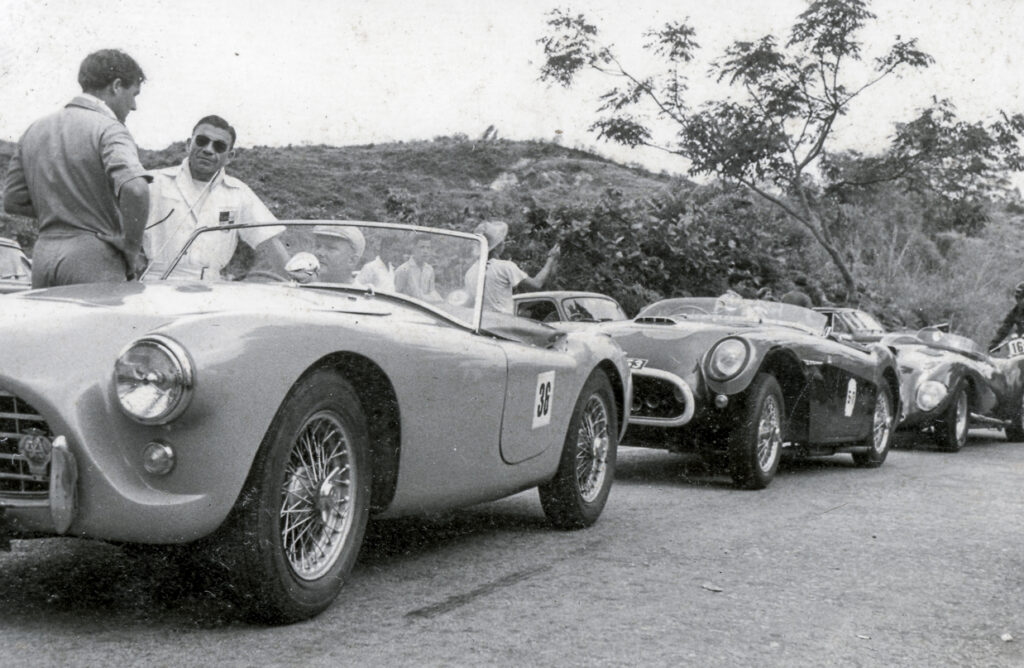
Bernard Arnold (in sunglasses) at a Singapore speed event in the early 1960s. The Cooper Jaguar is the third car in the photo. In the front is Barry Swann’s AC Ace (Swann is seated in the car) and behind the AC is Yong Nam Kee’s Fatso’s Delight Austin Healey 100-4 BN1.
Brian Stock, then based in Kuala Lumpur, purchased the car and wasted no time. He had it down in Singapore for the 1964 Grand Prix but mechanical trouble made him one of the absentees – which included Barry Swann in the ERA R2A and Eric Cooper in the Turner Climax, amongst others. The race was eventually red-flagged due to calamitous weather so results didn’t count for the 1964 Grand Prix.
On 24 May 1964, at the 2nd Installation of the Sultan of Perak Kilometre sprint at Batu Gajah 54, the Cooper Jaguar’s new owner took the car to two class wins and set FTD. In comparison to his twin cam MGA, his subsequent purchase of the ex-Chan Lye Choon Lola FWE Climax and the ex-Rodney Seow Merlyn Mk5, the car must have been a hairy one to drive. Indeed it was. Stock found it “indecently fast” and frightened himself into parking it permanently although he raced in the 1964 TAR races (5-6 July 1964) in Petaling Jaya. Come September, Stock put the car up for sale at the Seremban Sprint (held on 27 September 1964), offering it as a Cooper Jaguar with experimental D-Type Le Mans 55 150mph engine and asking M$4,500. “Have spares, will haggle”, he wrote in his advertisement. That weekend in late September, Kuala Lumpur-based karting enthusiast John P. Toohey raced it. On 15 May 1965, Stock advertised the car once more: “Cooper Jaguar ‘D’ Type engine Sports Racing colour red. Taxed & Insured $4,700 ono. For details apply B.W. Stock, Fosters Smokehouse, Cameron Highlands.”
JUNGLE CAT
JUNGLE CAT: It must have found a buyer because by the Tunku Abdul Rahman Circuit Races in Petaling Jaya in July 1965, Peter J. Arnold 56 showed up with the Cooper Jaguar. That too was short-lived because at the end of March 1966, Singapore race engineer and workshop owner Tan Ah Bee offered the red car for sale, located at his workshop at 32 Grange Road. The asking price was now $3,500. This was lowered to an even more attractive S$2,500 57, the price of a second hand MGA 58. It was an irresistible offer and James Watkins 59 who, together with fellow teacher Eric Cooper (who would also end up buying the ex-John Tse/Rodney Seow Elva Mk7 Climax in the late 1960s), may have been better informed of the car’s history, snapped it up though it doesn’t seem to have been in time for either to race the car in the 1966 Singapore Grand Prix.
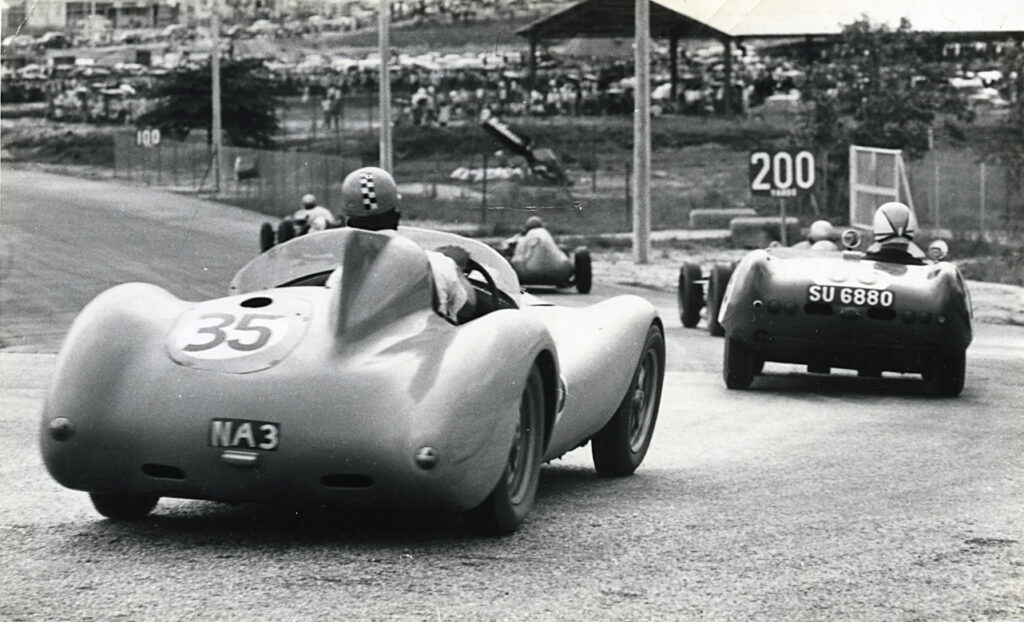
The TAR races in Petaling Jaya, 5-6 July 1964. #35 Brian Stock chases Johore bus company owner Andrew Heng (#89 Lotus 17). Stock found it “indecently fast” and frightened himself into parking it permanently. He advertised the blue Cooper Jaguar sports car (with ‘D’ Type head) for sale at Chequered Flag at Ipoh Road in Kuala Lumpur for $4,850 (advert dated 1 June 1964).
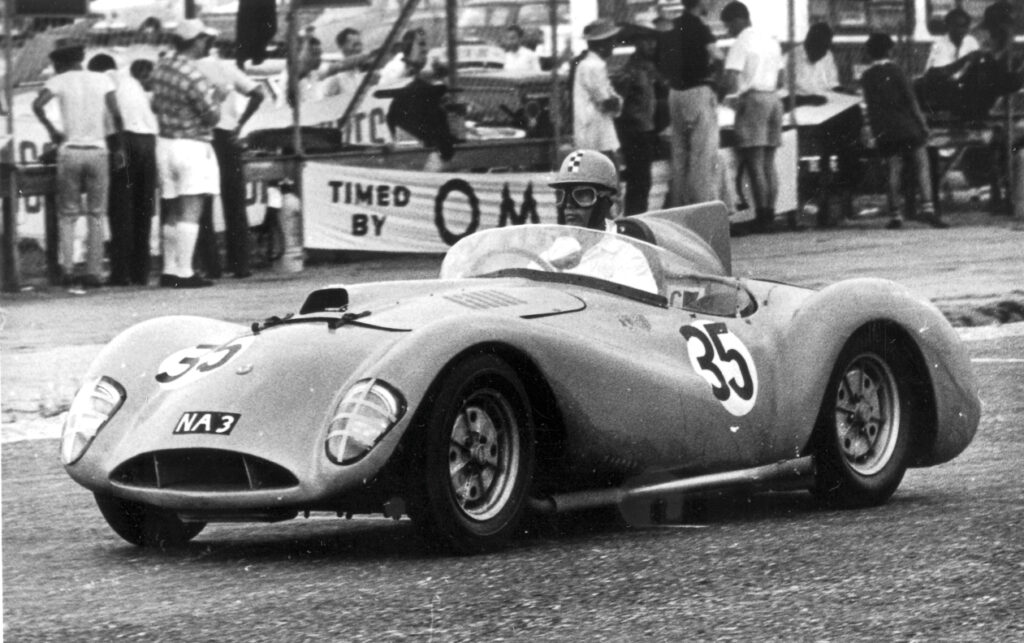
The Cooper Jaguar racing in Selangor, July 1964.
We see both Watkins and Cooper in the #79 Cooper Jaguar (2,483cc) entered in Class 12 (Sports & GT Cars 2001-3000cc) as the only class entrants for the Singapore Motor Club’s Festival Sprint on 7 August 1966 at Boon Lay Road. Eric Cooper won his class in the Sports & GT race (2001-3000cc). Watkins entered it at the Gap Hill Climb on 27 November 1966 and won Class 12 (Sports & GT cars 2001-3000cc), beating a Triumph TR4 in the process. According to Mini racer Ken Nelson’s report in the January 1967 issue of the Forces Driving Club magazine, “the car sounded much healthier than it had at its last appearance.” We do not know which “appearance” Ken was referring to but presumably it was at the Festival Sprint in August or the 25 September Rothmans Thomson Road Sprint – for which we have no details of the Cooper Jaguar’s appearance. Still, his time of 52.82 sec. was way off the pace of Mike Heathcote’s FTD in a Brabham (43.31 sec.). In fact, the Cooper Jaguar was three seconds off the pace of Alan Davis’ Mini Cooper S and nearly three seconds off the pace of the locally-built 3.4-litre Jaguar-engined Ban Sing Special.
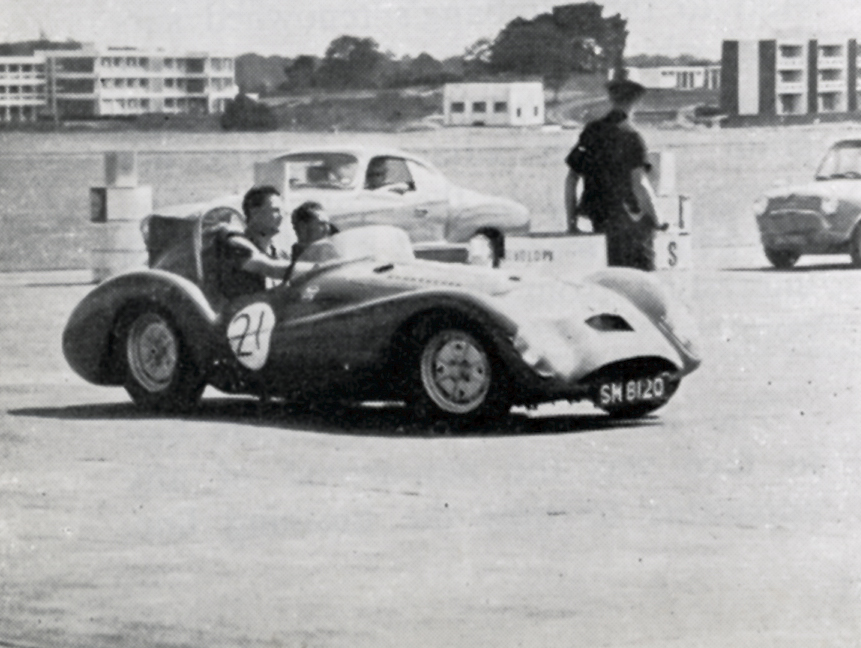
The Cooper Jaguar, with both Eric Cooper and Jim Watkins aboard at the Simbang Spring on 22 January 1967. The now carried Singapore road registration.
With both Eric Cooper and Jim Watkins based in Singapore, it was only natural that they attended most of the local events. To kick off 1967, the Forces Driving Club held their Summer Sprint at the Royal Naval Air Station, HMS Simbang, in Sembawang. This was an 800 yard course of hard squares of concrete but on this occasion (22 January 1967), the usual course was compromised by the presence of helicopters. The details of this “autotest” do not concern us here except for the writer to say that Eric Cooper and Jim Watkins had entered the Cooper Jaguar and were fighting it out for a class win. Eric Cooper took the win, and set 3rd FTD that weekend, FTD going to John Harwood’s ex-Mike Evans Lola Mk3.
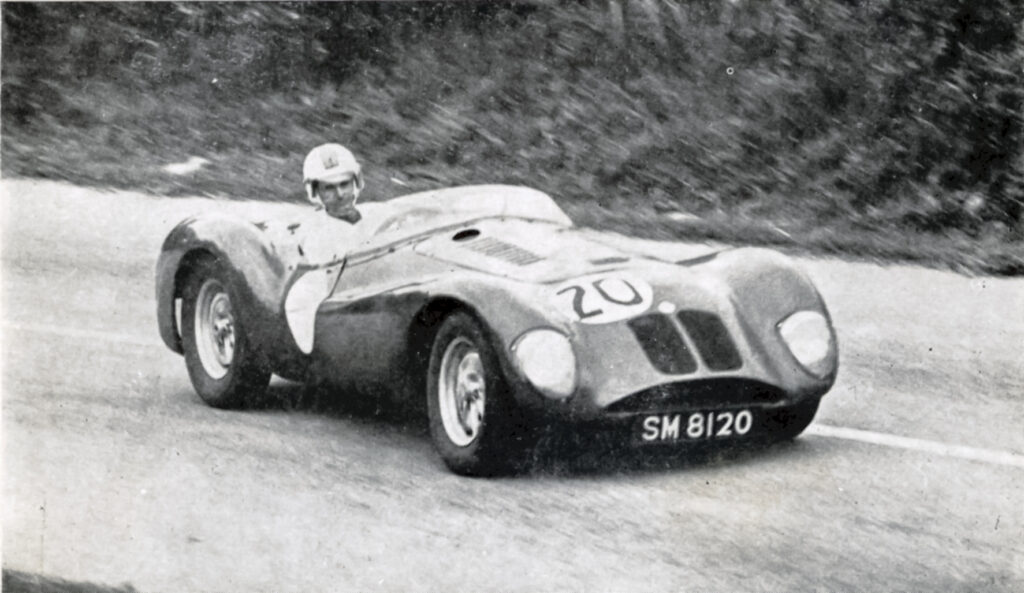
Further cooling measures were prescribed for the Cooper Jaguar at the 22 October 1967 Gap Hill Climb in Singapore. They called it the Cooper-Watkins duel – this time in Jim Watkins’ Cooper Jaguar. Cooper set a class record of 50.39 seconds in the car, a second faster than Watkins’ time.
Cooper and Watkins shared the car for the 1967 Singapore Grand Prix, the smaller-built Cooper driving in the Grand Prix, Watkins in the Sports & GT race. Did Watkins take the car up to Batu Tiga in September for the inaugural Batu Tiga races? He wasn’t featured in the Grand Prix results though in the official program the car was entered as #20 in the Sports Cars race as well as the Grand Prix. The following week, the car appeared in the Johore Grand Prix, with Watkins driving it in the 25-lap Sports and GT support race running #20.
While information is scarce, the writer was able to obtain the timing sheets which shows the Cooper Jaguar starting 9th on the grid and making its way up to 6th by the end of the race, finishing behind Peng Tsu Ying’s and Lou de Marco’s Lotus Super Sevens. It doesn’t appear that the car qualified for the Grand Prix. Cooper, International School headmaster and a squash enthusiast, also drove the car at the Gap Hill Climb on 22 October that year and established a Class 12 record for Sports & GT Cars 2001-3000cc with a time of 50.39 seconds (which stood for a number of years). Ever wondered why it was sometimes referred to as Cooper’s Jaguar?

A panoramic shot showing the Cooper Jaguar (#20) at the 1968 Singapore Grand Prix, sans rear headrest and fin and now sporting a rollover hoop and Kamm-style tail. The 15-inch magnesium Cooper wheels had been replaced and the front end now had late series MGA disc brakes.
There wasn’t much by way of upcountry racing for Watkins or Cooper in 1968 outside of the Grand Prix races in Johore, Selangor and Singapore. The car was entered for the Johore Grand Prix of September 1968 but not for the First Malaysian Grand Prix at Batu Tiga the weekend before Johore. At Johore, Watkins was entered in the Sports Cars race (20 laps), race entry number 20, while Cooper was to race the car in the 60 lap Johore Grand Prix proper. Neither were listed in the results.
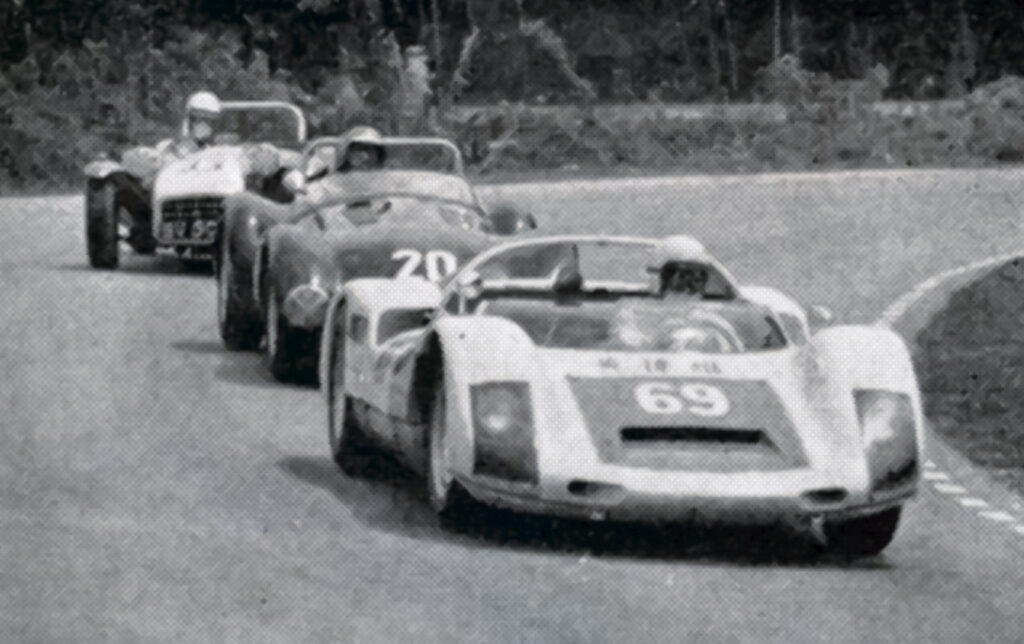
The Cooper Jaguar was plagued with overheating problems during the 1969 Singapore Grand Prix weekend. Here Jim Watkins trails Richard Wong in the Porsche 906 Carrera [See BEYOND JUST A SPYDER] round Peak Bend in the 15-lap Sports & GT Cars race.
For 1969, a rally man, 37-year-old Scottish Staff Sergeant from RAF Changi and Club Captain of the Forces Driving Club, Joe Minto, raced the #20 Cooper Jaguar in the 5-lap BMC Trophy support race to the Singapore Grand Prix, the car entered by James Watkins. It was Minto’s first race in the car; he clawed his way up the grid, the Jaguar motor probably one of the more powerful out there against the Minis, Singer, Volvo and Triumph. He made his way up to third at one point before a blown head gasket put a steamy end to his race, 60 and compromised Watkins’ entry for the 15-lap Fraser & Neave Trophy Race for Sports & GT cars. Watkins must have managed to get the car fixed because he won his class (Class 5, a single entry) in the race with a rather slow fastest time of 2:49.9 (that’s slower than the fastest time set by T. Asano in a Mazda saloon (up to 850cc). Watkins was last in the race, completing just seven laps.
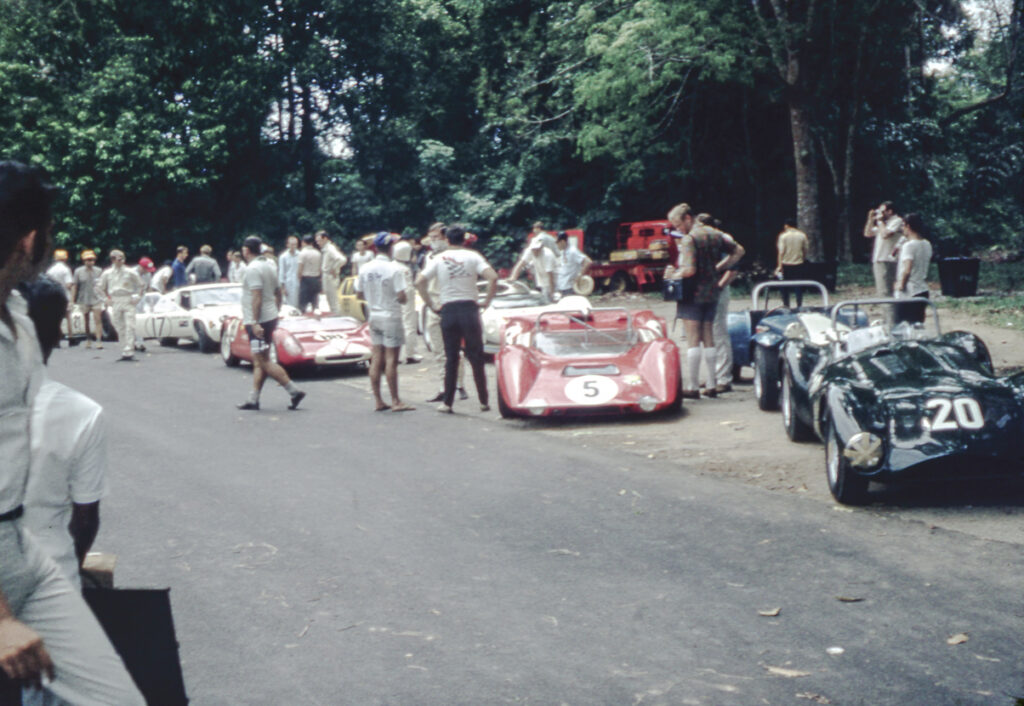
Paddock for the sports cars in the 1969 Singapore Grand Prix. The Cooper Jaguar is to the extreme right complete with rollover hoop and revised rear bodywork. The car faced formidable competition – an Elfin 300, Lotus 23 and Lotus 47 appear in this photo.
The old Warrior’s body had by now been through several alterations and was looking rather ghastly. Also, its Negri Sembilan road registration had been replaced by Singapore registration number SM8120, giving it a new lease of life on the island. It soldiered on for the next four years in the hands of Watkins and Cooper, usually entered under the FEAF 61 Motor Sports Association banner.
By 1970 this battle-hardy car was no longer considered competitive machinery. In fact, it was more of a “bitza” and now sported wider wheels, revised rear bodywork and disc brakes (done during Bernard Arnold’s ownership). Its historic status was hardly worth recognising either and like most race cars that were stuck on the island, it faced a very uncertain future. Throughout the period, the car was listed as having a 2.4-litre Jaguar motor.
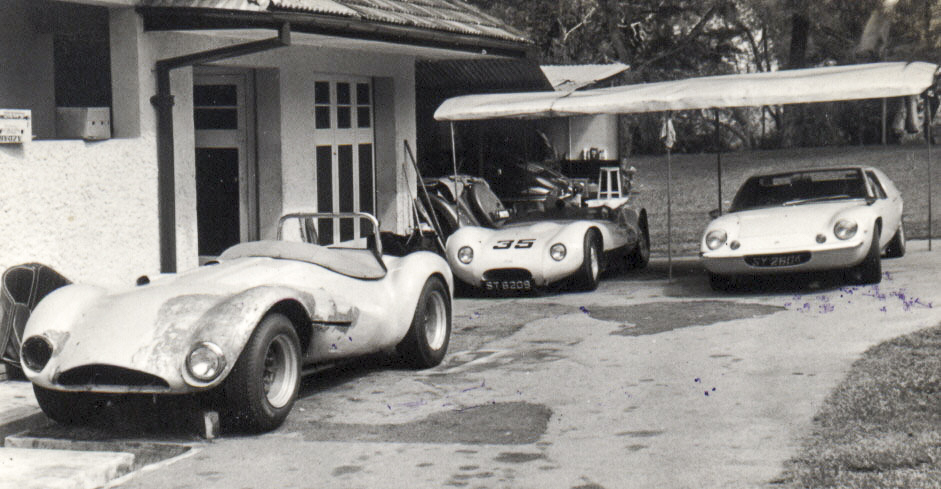
Pre-painted Cooper Jaguar, looking more mod-sport than classic sports racing car. Photo taken at Ken Evens’ Woodleigh home in Singapore, early 1970s. The entire front bonnet was hinged at the front. Source: Rolf Evans
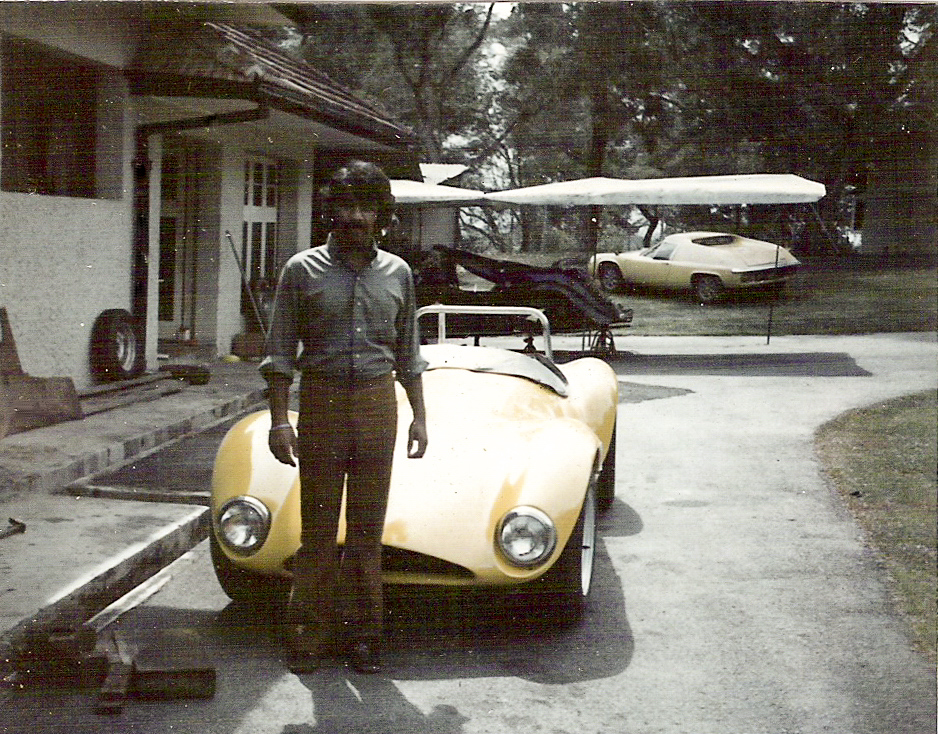
The Cooper Jaguar at Ken Evans’ Woodleigh Park home in Singapore circa. 1971, with up-and-coming Malaysian racing star Sonny Rajah front of the car. Source: Rolf Evans
SAVED DOWN UNDER
SAVED DOWN UNDER: In 1970, Australian serviceman Tim I. Robertson shared the car with Eric Cooper at the Gap Hill Climb in November (where Robertson, the new owner, damaged the rear by clouting a concrete post and a tree on his second run) 62 and at the Rothmans Old Upper Thomson Road Sprint on 6 December. By then the rear end had been repaired though the aluminium remained unpainted. Robertson won his class at both the Gap and Old Upper Thomson Road.
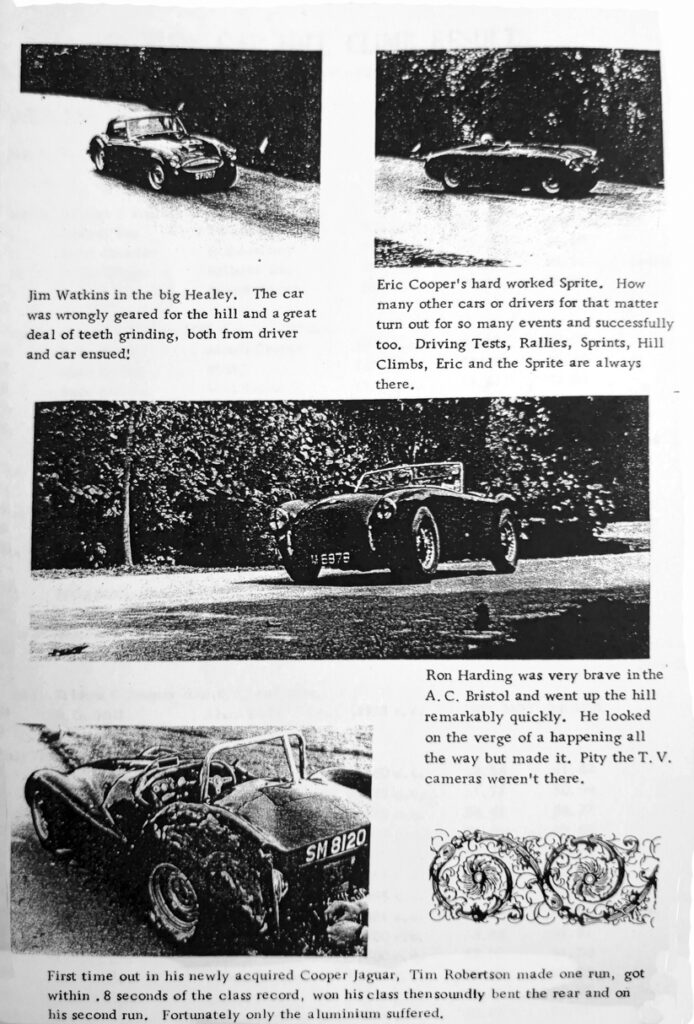
Photo of the damaged car appeared on pg.27 of the Singapore Motor Sports Club’s magazine, Vol.2 No.11, November 1970. Note the absence of the rear backrest and fin and the addition of a roll over hoop and much wider 15-inch rear wheels (probably from a Triumph TR5/6, which had a PCD of 4.5in, identical to the original Cooper wheels). The car now had a chopped rear end with Ford taillights. Gone were integral Cooper magnesium wheels/drums at the front as well.
The Cooper Jaguar’s final entries in major events in South East Asia were in the Singapore Grand Prix: 1970 Fraser & Neave Trophy Race for Sports & GT Cars with Jim Watkins, listed with a 2,482cc motor, set a class record at 2 min 47.7 sec (he was the only entrant in that class); 1971 Sports & GT support race (20 laps) with Tim I. Robertson, with 2,483cc motor). The Cooper Jaguar finished fourth in that race, behind John Green (Chevron B8), Chong Boon Seng (Lotus 23B) and Danny Neal (Elva Mk7 SCA) and with Indonesian Tjepot glued to Robertson’s tail in the little 798cc Honda S800 63 Roadster. Interestingly, there were two other entries in Robertson’s class (2,000cc and Over), James Watkins in a Big Healey and Roger Matthews in a Triumph.
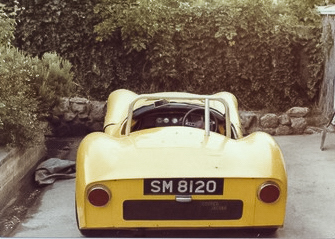
The chopped off rear end of the Cooper Jaguar. Photo courtesy Brett Boughton/Doug Young.
Thankfully Robertson felt it worth his while to cart SM8120 home to Australia after the 1971 Singapore Grand Prix, saving it from almost certain extermination in Singapore. Did the old Bristol motor accompany the car in a separate box when Brian Stock acquired it in 1964, or had it been disposed of when Chequered Flag Engineering folded following Arnold’s departure to the UK for treatment in 1963?
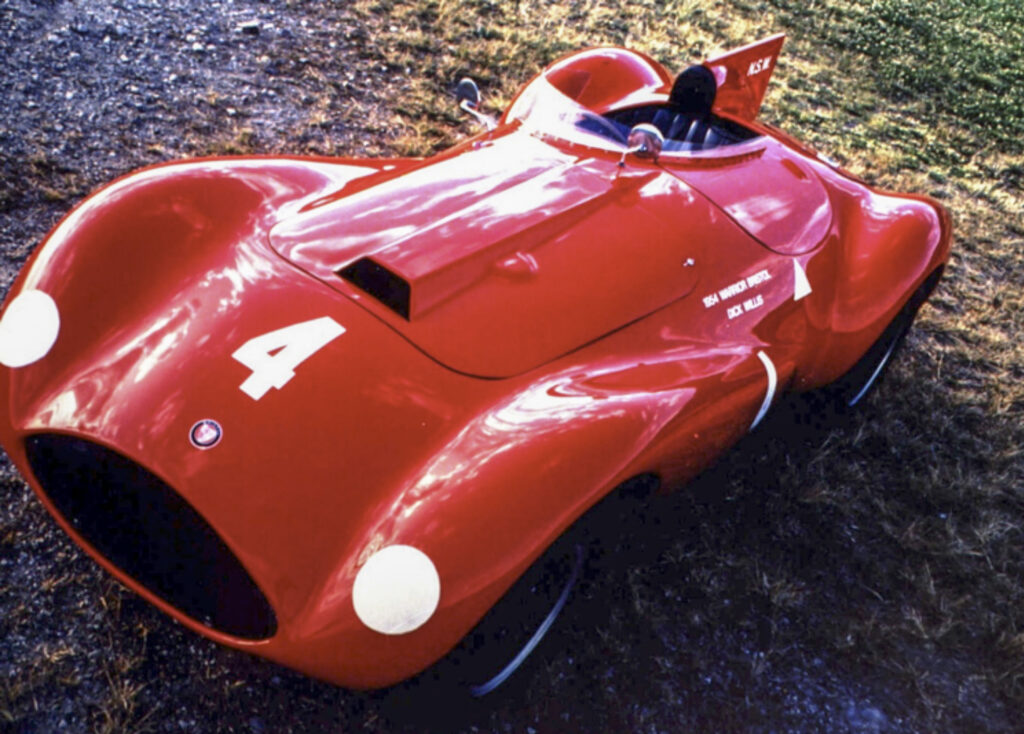
The Warrior Bristol when Australian Dick Willis owned it [1992-1999]. It now had a Bristol motor and the bodywork mirrored what Bernard Arnold had when he first acquired it in 1956, the modified Kamm-style tail with Ford tail lights had been discarded in the rebuild. Photo courtesy Dick Willis.
In Australia it was later purchased from Tim Robertson by Doug Young and Clive Philbrick. Philbrick rebuilt the Jaguar motor and they retained existing wider Triumph TR5/6 wheels. This writer’s communication with Doug revealed that at the time of purchase from Tim Robertson, the Jaguar motor had a B-Type head (as found on Mk IIs and XK150s) but the intakes were especially well fabricated for the triple Weber carburettors that came with the car. The camshafts were D type. The con rods had been polished to a mirror finish and the motor did not have an oil filter.
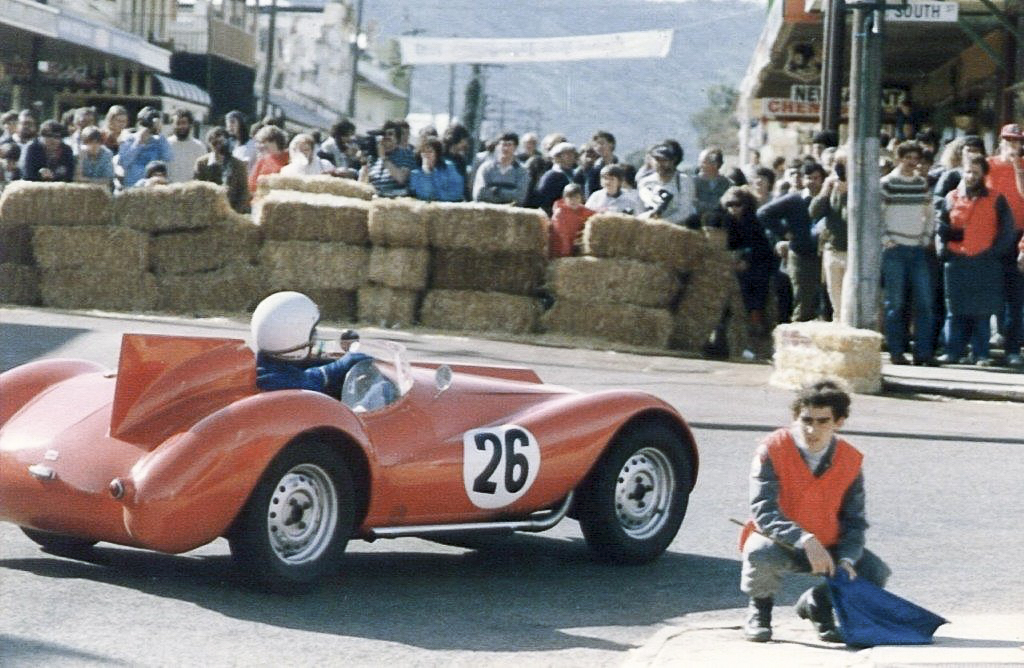
Racing the rebuilt Warrior Bristol in Western Australia. Photo courtesy Dick Willis.
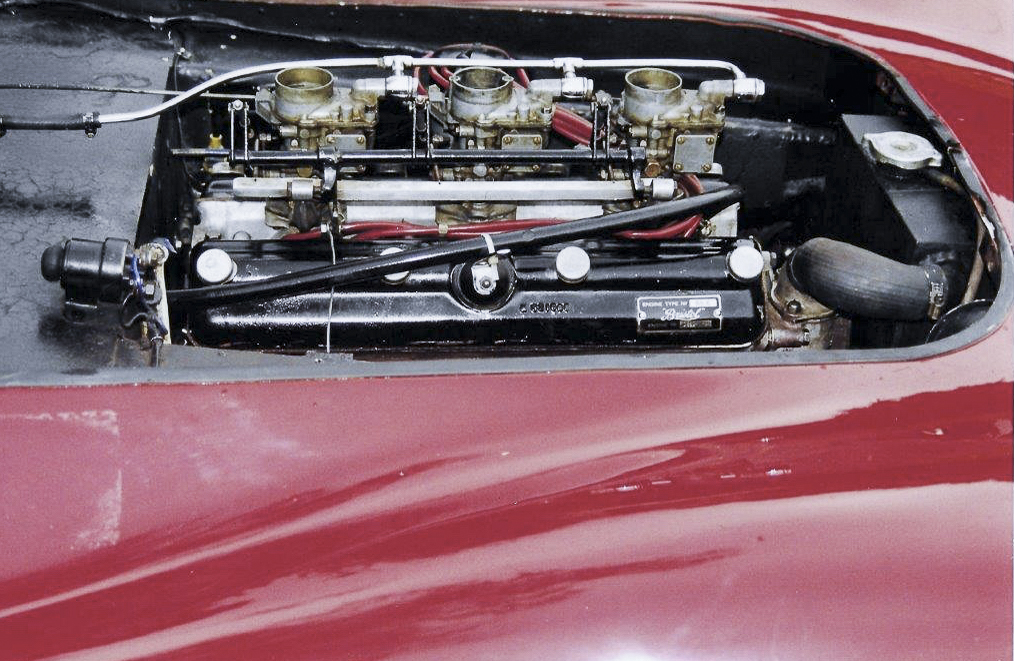
Back to being Bristol powered. Photo courtesy Dick Willis.
They later sold it to former RAAF officer Ian Boughton. Ian had himself been based in Singapore in the early 1970s and had raced his own cars in support races for the Singapore Grand Prix. Perth-based Boughton, soon to be hooked on Bristol power, was a skilled hand at intricate panel work. He painstakingly rebuilt the rear end to its Warrior Bristol shape. The Jaguar motor was replaced by a Bristol unit. It must have been painstaking work because the amount of changes (both in design and mechanically) done to the original Warrior Bristol would have been quite significant over the course of the its 16 or so years in South East Asia.
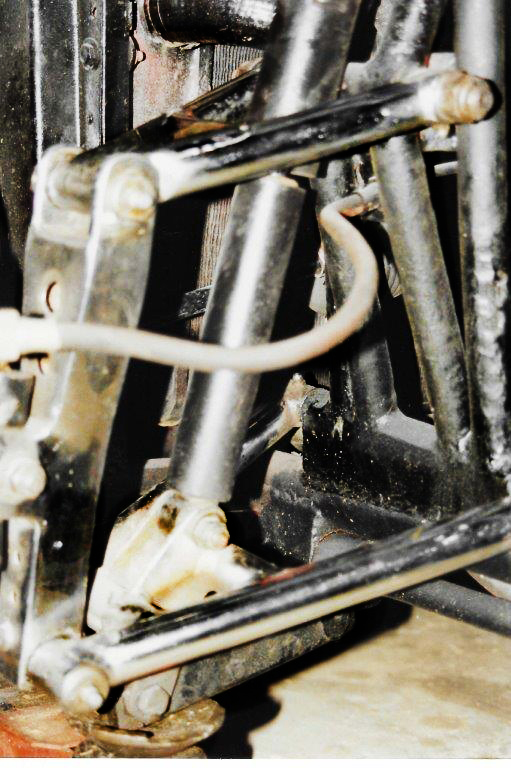
The Warrior’s double wishbone front end with visible torsion bar from a photo taken by Dick Willis when he owned the car in Australia between 1992-1999.
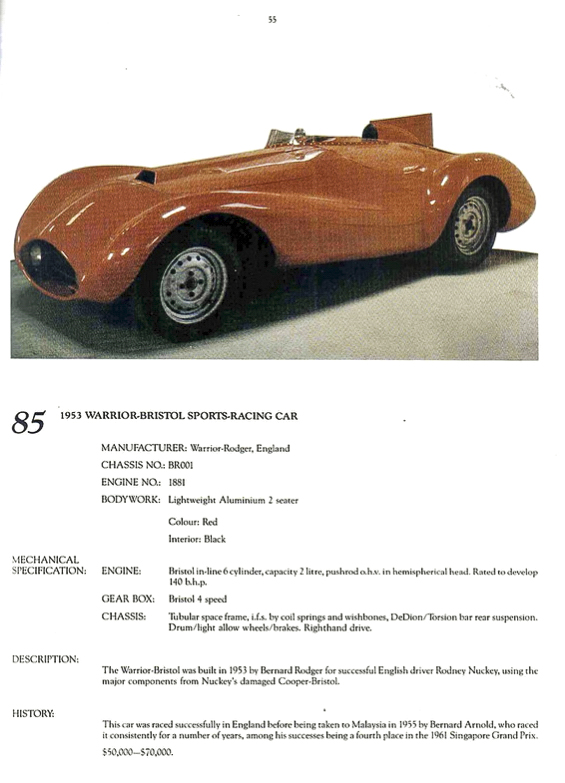
The Warrior Bristol was offered at Christies Australia (Melbourne) in June 1991.
Its last Australian owner was Dick Willis. Dick had some of Ian Boughton’s correspondence with Jim Watkins that shed some light on the front suspension: “…[Jim] described the front suspension when he got it as Cooper wishbones and uprights and an unsecured transverse leaf spring below the frame which achieved a sliding roll centre and made it bloody murder to drive. He put the torsion bars on the front.” Willis also noted that when he acquired the car, it had a de Dion rear axle suspended with torsion bars and located with radius arms and a Watts linkage, which was probably a modification that took place sometime following its arrival in Malaya.
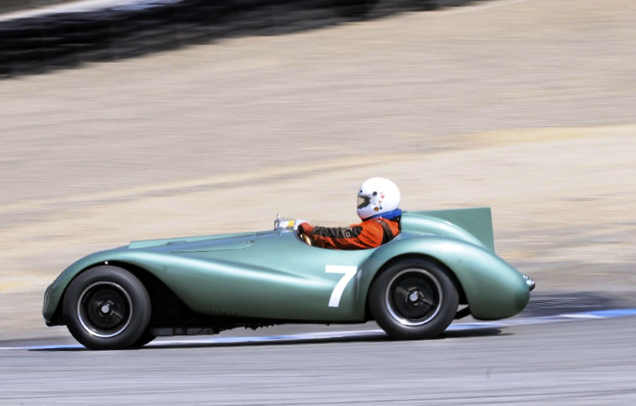
The Warrior Bristol at a recent Monterey Historics meeting. The car has been with the same owner since 1999. Source: ConceptCarz.com
WARRIOR ACROSS THE POND
ACROSS THE POND: The Warrior then found its way across the Pacific to the United States in 1999, to Jack Perkins. Perkins continues to race the Warrior Bristol on the west coast. This writer last saw it in action in 2012 at Laguna Seca during the Monterey Historics. Perkins recalled: “When I got the car it had MkI front mag wheels with the integral brake drums removed and Alfin front drums in place. When I received the car [purchased from Dick Willis] I replaced all four wheels with 15-inch MkII wheels made for the Cooper Club by Crosswhaite and Gardner.” He still has the MkI wheels. Jack explained that he had seen the Warrior advertised in a vintage car magazine here in the US by a gentleman from Australia.
Perkins couldn’t take the risk and buy it sight unseen. “Well, not exactly. I wanted to make sure I could fit into the cockpit, so I gave the owner my body measurements and I said, ‘I’m going to think very seriously about buying this car because I already have Bristol parts from my Ace.’ So he found a mate of his that was about my size and stuffed him in the car,” Jack explained. First impressions upon driving it was not good. “I’ve never had a car that understeered as much as this. It was horrible,” he recalled. “I couldn’t believe what kind of push it had. How could anybody have possibly driven this car? The other thing that’s my practice is that I go through the suspension of a car I buy, make sure that axles and stub-axles are crack-tested. Well, I didn’t do it with this car. So the second time I had it out, it lost one of the front wheels. And I’ve lost three of the four wheels at various times because I didn’t have them crack-tested like I should have. It’s all part of owning old cars.”
SUMMARY
SUMMARY: The Warrior Bristol/Cooper Jaguar raced in Malaya/Singapore during the period 1956-1971, encompassing the Malayan Emergency (battle against communist insurgents), independence (Malaysia, 31 August 1957), Konfrontasi (the Indonesia-Malaysia confrontation between 1963-1966), merger-demerger between Singapore and Malaysia (1963-1965), Singapore’s independence (9 August 1965) and the British troop withdrawal from Singapore (1971). The car participated in the Macau Grand Prix, the fist and only RAF Changi Circuit Race, the first Singapore Grand Prix and the last Johore Grand Prix (1968). It arrived with a straight-six Bristol BS4 motor and left Singapore with a 2.4-litre straight-six Jaguar motor, going through a slew of modifications to brakes, suspension and bodywork, most of which was undertaken by Bernard Arnold’s Chequered Flag Engineering works in Singapore.
In international circles, its historical importance may deemed to have ceased once it left the UK for the colonies in 1956. In local context, the Warrior Bristol/Cooper Jaguar reflected the popularity of motor sports in the region, judging by the number of events organised over that period. It also showed that a complex contraption built first as a Formula 2 car and later reconstituted as a Special in the UK, was able to continue to both compete out in the colonies and evolve under the difficult conditions of operating in South East Asia, reflecting the skill of the mechanics/fitters/engineers/gas welders available to Arnold in the early 1960s. It was the same for everyone who raced in this part of the world – from the young chap who raced the humble Mini Minor till it broke in two, to the Lim Peng Hans, Chia Eng Quees and Tan Ah Bees of Singapore, who constructed and raced their own Specials.
They say that racing improves the breed. In this case, racing also had an overall impact on the skillset of local workshops and the humble mechanics tasked with preparing the cars for the regular sprints and hill climbs up and down the Peninsula.
By the 1980s, such historic cars had started to grow in importance internationally but were really a taboo subject locally. Had the car remained in Singapore, it most likely would have been scrapped, confiscated, or simply rotted away due to the harsh environment, harsher tax environment, lack of storage space as the island rushed its urbanisation program, and, a ban on all motor racing on the island from late 1973. That was the fate that befell nearly every single locally built Special and race car that remained on the island post 1973. The Warrior Bristol survived, and was raced/reconstructed/rebuilt/restored in Australia by several knowledgeable enthusiasts. Today it continues to be campaigned in the US in historic racing – closely resembling the car that first landed in Negri Sembilan in 1956.
Words by Eli Solomon
Copyright © Eli Solomon & Rewind Media Pte Ltd
Send comments to [email protected]
Ownership History in Asia
Bernard Arnold – 1956-1963 [road registered NA3]
Brian Stock – 1964-1965 [road registered NA3]
Peter Arnold – 1965-1966 [road registered NA3]
James Watkins/Eric Cooper – 1966-1970 [road registered SM8120]
Tim I. Robertson – 1970-exported to Australia [road registered SM8120 while in Singapore]
Acknowledgements (not in any particular order):
Resources referenced from the RMA library:
Nye, Doug. Cooper Cars. Motorbooks International, 2003.
Pritchard, Anthony. Specialist British Sports/Racing Cars of the Fifties & Sixties. Mercian Manuals Ltd, January 2000.
Blanden, John B. Historic Racing Cars in Australia. John B. Blanden, 1979.
Blanden, John B. Historic Racing Cars in Australia. Turton & Armstrong, 2004.
Green, Barry. Driven to Succeed – The Alec Mildren Story. Barry Green, February 1999.
Urban, Roland. Les Métamorphoses du Jaguar Spéciales, Modifiées, Hybrides (Gestion Economie). 1993.
Clausager, Anders Ditlev (Editor). Jaguar C-type, D-type & Lightweight E-type Register. Anglo Danish Publications ApS, 2014.
Whyte, Andrew. Jaguar – Sports Racing & Works Competition Cars From 1954 [Volume 2]. Foulis, 1987.
Appleton, John. Cars in Proflie Number 11, August 1973 – Jaguar D-Type.
Martin, Brian James. Jaguar From the Shop Floor. Veloce Publishing, May 2018.
Murray, David. Ecurie Ecosse – The Story of Scotland’s International Racing Team. Stanley Paul & Co., 1962.
Gauld, Graham. A Social History of Motor Racing from the Fifties to the Nineties. Graham Gauld, 1992.
Newsome, Philip: Colour & Noise, 1960 – The Best Yet. Studio Publications, 1993.
Solomon, Eli. Snakes & Devils – A History of the Singapore Grand Prix. Marshall Cavendish, 2008.
Footnotes
- Bernard Sydney Arnold [1914-1963], wife May Elizabeth Louisa Arnold. His wife left him and moved to Victoria, Australia circa. end 1954. They had a daughter, Eva Michell Arnold.
- The crash that destroyed the T23 Cooper Bristol took place in the Curtis Trophy F2 race at Snetterton on 17 October 1 953. All subsequent Nuckey entries in the T23 are of the rebuilt single seater T23 [the Alec Mildren car – see below].
- The 1955 Tojeiro-MG looked remarkably similar in design to the Warrior Bristol.
- See Nye, Doug: 2003 Cooper Cars. Motorbooks, 2003 edition [not the 1983 Osprey edition]. Here’s the text, pg. 86 of the 2003 edition: “It [the Formula 2 Cooper Bristol MkII car] was badly mangled, and Bernie Rodger was commissioned to build the salvaged engine and gearbox into a new tubular sports racing car frame of his own design, which was christened the Warrior-Bristol. Both Nuckey and Roger Biss drove this car in the 1954 sports car events…”
- Bernie Rodger later went on to become one of the founders of Peerless Cars Ltd (1957-1960). When Peerless Cars Ltd failed, Rodger’s Bernard Rodgers Developments (BRD Ltd) resurrected the company and marketed the cars as Warwicks from Colnbrook in Buckinghamshire between 1960 and 1962. As an aside there was at least one Malaysian registered Peerless GT and one Singapore registered Warwick GT [see photo in RACING IN THE FEDERAL CAPITAL].
- According to Doug Nye in Cooper Cars, the Nuckey Mark II-Bristol “was meanwhile resurrected, presumably round a replacement chassis frame, and he [Nuckey] raced it in 1954. Australian visitor Alec Mildren then acquired it through the Cooper factory, and it arrived in Australia that December.” We turn to Barry Green’s biography, DRIVEN TO SUCCEED – The Alec Mildren Story, for more on the rebuilt MkII Cooper Bristol: “After further discussions with Brabham, Mildren cabled the factory [the Cooper Cars factory]…He wanted a topline car – he hoped this machine would fill the bill…The car, which had completed one season’s racing in England and the Continent, had been driven by Rodney Nuckey and had chalked up a fair amount of success.” In fact, the C-B was the fifth of its type built by Cooper Cars and had won the 1953 and 54 Helsinki GPs. It came with a blot on it pedigree papers, though – Mildren recalled it also had “a stiff shunt” before he acquired it.” Some shunt indeed!
- Possibly a play on Ford’s pre-war Lincoln “Zephyr” name.
- Singapore Sprint record, February 1955.
- Malayan Sprint record, February 1955.
- Major Michael Vaughan Benthall of 7GR [d. 7 September 2008].
- For a history of this club see CLUBBING IN SOUTH EAST ASIA
- James George Milne Ferguson was an active member of the motor sports community from before the war in Malaya. He inherited the plantation business of his father James Scott Ferguson. Bill Ferguson later became the Chairman of Malayan Producers Ltd at Tanjong Rambutan at the age of 40. He ran the Changkat Kinding Estate, Tanjong Rambutan in Perak. For more on Bill Ferguson’s motoring interests pre-WWII, see THE LOST CREAM CRACKER.
- 1951 was a pivotal year in Malayan motor sports. With a well-documented record book of success around the world, it may have come as a surprise to many that it took so long for the first Cooper to arrive in Malaya. The car in question was a Mk IV Cooper JAP with a 500cc engine, brought in by Perak-based motoring enthusiast J.G.M. ‘Bill’ Ferguson. It made its debut at the Lornie Kilo in Kuala Lumpur in April 1951, winning its class. At the May 1951 Gap Hill Climb in Singapore it set FTD. Three-for-three was not too bad for the car, tuned by Wearne Brother’s Kuala Lumpur mechanic Stan Moore. An upgrade to a 998cc motor was executed for the more challenging Johore Grand Prix. Ferguson’s 998cc JAP-engine Cooper bore chassis 10-13-49 and the little car faced a gaggle of much larger machinery, including Jaguar XK120s. Bill Ferguson however, had the “Unfair Advantage” around Johore; his Cooper was take Garden Bend flat out in top gear. The car won the Grand Prix that year.
- Joseph Neil Kingsmill Moncrieff was born in North Adelaide, South Australia, on 2 June 1916. He was enlisted as a Flight Sergeant (SN 5348) on 28 November 1939 and officially discharged from service on 7 June 1948. On 23 March 1940, he married Joy May Oakes in Adelaide [see JOY BY DESIGN ]. He and Joy relocated to Singapore by 1947 (the author has not been able to determine the exact date of their arrival) for Qantas Empire Airways as the airline’s instrument engineer. He later transferred to Malayan Airways and his last position there was Chief Superintendent of Electrical Engineering. The Moncrieffs spent nearly two decades in the Colony. In January 1966, the family returned to Australia, at the time of the formation of Malaysia–Singapore Airlines (MSA) – the flag carrier of Malaysia and Singapore.
- James Alexander Milne, or Jimmy Milne to his friends, was born in Penang in 1910 to Capt. James Adam Milne (of Dysart, Fife, Scotland) and Lilian Grace Holmberg. Jimmy’s racing interests date back to the late 1920s at the Singapore Volunteer Corps/Straits Settlements Volunteer Force Gap Hill Climb. He continued to play an active part in Malayan/Singapore motor sports, racing in the 1940 Johore War Effort Grand Prix [see GENESIS & THE WINDS OF WAR]. The family migrated to Shanklin in the Isle of Wright in the 1960s. Milne passed away 19 February 1998 at the age of 87.[/efn_note] and the Chan brothers out of Singapore had been mopping up all the trophies at Sprints and Hill Climbs. Unperturbed, Arnold focused on the North Malayan events. At the Penang and North Malaya Motor Club’s Sungei Nibong standing-start Kilo Sprint (27 March 1955) he set FTD with a 29 second blast. The car was shared with Dr. Barney V. Hassan (Hassan ran it in the Unlimited Racing Cars class).
Getting to Sungei Nibong was no mean feat in the midst of the Malayan Emergency (1948-1960), where, wrote then Automobile of Association of Malaya Chairman C.O. Jennings (himself an avid motor racing man), “It is fantastic to imagine that bandits or ruffians are lurking behind every blade of grass in Malaya.” 15“Nonsense About Bandits says A.A. chief on road risks.” Straits Times, 7 April 1954, pg.5.
- Roger D. Biss raced the Warrior Bristol in the National Brands Hatch Sports Cars Unlimited race 11 April 1955, then at the MMKMC Silverstone Formula Libre race 14 May 1955.
- J.D. Lomas, winner, BARC Aintree, 13 August 1955.
- The Tanah Merah Estate at Port Dickson belonged to United Sua Betong Estates Ltd. Before Bernard Arnold arrived, the Estate’s manager was Mr H.T. Piper (retired in May 1949). The estate planted rubber.
- Straits Times 7 April 1957, pg. 22. The report revealed that Arnold was now a Singapore resident. “The Cooper-Bristol is priced at $34,000.”
- Barwell Motors of Leatherhead Road, Chessington, Surrey, was run by Mr Lucas and Mr Golding. The company did a great deal of gas-flowing work on cylinder heads and had their own air-flow chamber. The partners had a working relationship with AC Cars and by 1959 were tuning an average of two Bristol engines per week (as fitted to the Ace and Aceca models). Source: MotorSport Magazine, December 1959: Looking Round the Speed Shops.
- Francis Jan Bussell first appeared in the Cooper JAP MkIV at the 23 March 1958 Lim Chu Kang Sprint and continued to race it till the Gap Hill Climb on 4 October 1959 in Singapore. The car was advertised in the SMC Gazette, September 1959, complete with 998cc JAP engine, trailer and some spared – asking $2,200. It was purchased by planter Peter G. Cowling.
- Dr. Frederick ‘Freddy’ C.B. Marshall, Ph.D.,D.I.C., B.Sc., F.R.I.C., M.B.A.C., [d. 17 July 1962 in Singapore, aged 53] was an industrial chemist who established Malayan Laboratories in 1952 (10 Gilstead Road, Singapore 11, later on at Imperial Court, 79 Anson Road from 1 May 1953) as an industrial research lab for research into drugs, insecticides, minerals, water, food, palm oil, metals, cement etc., etc. Marshall was known in Singapore as the ‘Radio Scientist’. During the war, he worked on rocket and guided missile development with the British Ministry of Supply (Marshall was involved in the development of the Z anti-aircraft weapon system. Later on he did experimental work on diesel, petrol and smokeless fuel from coal. During the slump of the early 1930s, he worked in the film business as an assistant to a film producer. Marshall came to Kuala Lumpur to work for the Department of Chemistry. He resigned in August 1951 and joined H.R. Marchand’s Malayan Laboratories [Straits Times, 19 August 1951, pg. 5]. Malayan Laboratories, set up in Singapore in 1952, handled analytical research for local industry – from palm-oil to rubber, tin, bauxite and iron-ore. The company was wound up in September 1960 [Straits Times, 8 September 1960, pg. 13]. Marshall however had established The Analytical Laboratories Ltd, 10 De Souza Street, Singapore 1, on 1 March 1955 [Straits times, 1 March 1955, pg. 10]. The De Souza Street office was a temporary address. On 1 April the company moved to 30-B Church Street, 2nd floor, with entrance at the corner of Synagogue Street. This was a private consulting practice. Marshall married Geraldine in England on 23 November 1940. He was granted a decree nisi in Singapore in September 1954. Marshall had two daughters by his wife Geraldine (one was named Linda and partnered her father as co-driver at events in 1957).
- Straits Times 6 June 1957, frontpage. The photo shows Arnold kneeling by the wheel-less car, revealing just the brake shoes and no drum – an indication that this was a MkI set-up with the Cooper magnesium wheels having the 10in drums integrated into the wheels. No wonder Arnold lamented that he could never find a replacement set!
- The Numax hut was 30 feet long and 19 feet wide, rainproof and inflatable. It housed Bernard Arnold’s Lincoln V12 Special, his Warrior Bristol, and a third car.
- Singapore Free Press, 8 November 1957, pg.15. The report shows Arnold with two spare Cooper wheels.
- The background shows the William Jacks & Co. (Malaya) Service & Spare Parts Centre suggesting this photo was taken in Malaysia rather than in Singapore. The company, generally referred to simply as Jacks, dealt in insurance, rubber and tin, building materials, fire fighting equipment, radio (Jacks had the Philips radio agency), telecoms and electrical supplies, earthmoving and mechanical engineering plants, mining equipment, agricultural implements etc. The company wound up its Singapore registration and incorporated William Jacks Company (Malaya) Ltd. in the Federation of Malaya in May 1959. Prior to WWII, Jacks were the Upcountry distributors for Standard motor cars (Thornycroft handled the Singapore market).
- The Kajang Sprint of 27 July 1958 was meant to make up for the loss of the Lornie Kilo event. The event was held at Sungei Kantan Estate in Kajang. The “circuit” was 15 feet wide with a five-foot grass verge either side. The tarmac was undulating and laid over laterite. The course was run in a clockwise direction with cars starting individually at 10 second intervals. Bernard Arnold and his Warrior Bristol did not attend. It must have been interesting enough for competitors to come from all around Malaya and Singapore. Entries included Paul Gibbs Pancheri, C.O. Jennings, Rex Carkeek, Dr Barney Hassan, John Forde, Donald MacIver, Dr Freddie Marshall, Bill Cowie, John Reed, Gordon Haddock, Saw Kim Thiat, Bruce MacRae-Smith, Lam Theng Pew, Tony Huggett and Gerry Hunt.
- Tunku Mahmood returned to Malaysia in 1956 and briefly served as a cadet officer in the Johor Civil Service, taking charge of affairs in District Affairs, Land and Treasury departments until his appointment as the Tunku Mahkota of Johor in May 1959. Mahmood was appointed the Tunku Mahkota of Johor from 1959 to 1961, and Raja Muda from 1966 to 1981, by Sultan Ismail. On 29 April 1981, he was re-appointed as the Tunku Mahkota shortly before his father’s death. He discontinued the use of his first name after he became Sultan of Johor in 1981.
- Sultan Yussuff Izzuddin Shah Ibni Almarhum Sultan Abdul Jalil Karamatullah Nasiruddin Mukhataram Shah Radziallah Hu’an-hu, KCMG (15 January 1890 – 4 January 1963) was the 32nd Sultan of Perak, a state in the then Federated Malay States.
- Lea-Fiat 1767cc was a Lea Francis Special belonging to Mike G. Spragge. The 1767cc motor was from a Lea-Francis four-cylinder 14 model (produced between 1946-1954). It was said to have been produced with “factory” guidance.
- See CLUBBING IN SOUTH EAST ASIA for the backgrounf to the formation of the Singapore Motor Club.
- The car was a very rare Right-Hand-Drive Ferrari 250 GT Spider with a V12 2953cc motor that produced 240bhp at 7000rpm. This car, one of around 20, was originally exported to Hong Kong for George Baker’s International Service Corporation Hongkong, Ferrari distributor for the region. The Singapore Motor Club’s editor Loris Goring wrote: “The vehicle which aroused most interest was undoubtedly the immaculate Ferrari 250 GT Roadster, so ably demonstrated by George Baker during the day. This car, a V-12 3-litre, is most likely to become a permanent resident of Singapore; if you have the necessary $42,000, see Bernard Arnold about it….”
- Battista “Pinin” Farina (prior to changing his name to Battista Pininfarina in 1961) left Italy on 21 March 1959 on a three month “business and cultural” world tour that included Hong Kong, China and Singapore. He was in Singapore twice – once in April and a second occasion in June, when the George M. Baker Ferrari 250 GT was on display at Bernard Arnold’s Chequered Flag Engineering workshop. The car (priced $43,000) was featured in the Sunday Standard, 21 June 1959, pg. 22.
- Straits Times Notices, 1 November 1958, pg 12.
- Chequered Flag Arno-Kart Advertisement in the 1960 Johore Coronation Grand Prix Program.
- Roland Urban, in Les Métamorphoses du Jaguar Spéciales, Modifiées, Nybrids, notes the following about the Jaguar engine used by Arnold: “This mysterious Cooper-Jaguar was in fact built in 1953 as a Cooper-Bristol. It was exported to Singapore where it took part in local races before leaving for Australia, by now fitted with a three-litre Jaguar engine. According to the engine number this would seem to have been a works engine built for Le Mans which apparently disappeared from the racing department…!” [Ed. The engine number is not listed in Urban’s book, making it difficult to ascertain if it was an Ecurie Ecosse-derived or Jaguar-derived engine] or just a stock 2.4-litre (CR 8:1) with a D-type head, D-type cams, fabricate intakes and polished con-rods. In fact, Clive Philbrick, one of the Australian owners who rebuilt the Jaguar motor, recalls the pistons were short-skirted, CR was a high 9:1 “and the head had been shaved so far that the valves were a hair away from hitting the pistons…about 10 thou of an inch.”
- David Murray, owner of the Ecurie Ecosse racing team, ran his D-Type Jaguars with the 3-litre engines at Le Mans in 1958. According to Graham Gauld in Ecurie Ecosse – A Social History of Motor Racing from the Fifties to the Nineties, “With the 3-litre engine limit coming into force, Murray arranged with Jaguar for the conversion of his two 3.4-litre engines to 3 litres at a price of £380.00, but whether this was for each or for both there is no confirmation.”
- Communication with Australian owner Doug Young, November 2021. There was no room to install an oil filter housing between the block and the frame rails. This was addressed by the new owners Doug Young and Clive Philbrick in the 1970s. They installed a remote oil filter housing and raced it with the Jaguar motor prior to selling the car to Ian Boughton.
- Straits Times, 22 May 1961, pg. 14.
- Lt. Dominic Salwey Barrington-Brown (453078) [b. July 1937, d. circa 2010] was an officer in the Royal Armoured Corps.
- Richard ‘Dick’ Clinkard’s Singapore registered (SU2033) Big Healey 3000 was a 1960 model and had a 180bhp Ruddspeed conversion (Ruddspeed gas flowed head, enlarged ports, CR 9.3:1). The car was eventually sold to Hans Stocker who damaged it in the Malaysian Grand Prix of 1963, bending the chassis. The car was eventually offered for sale at Borneo Motors for $1,600 in June 1963.
- Peter Todd’s XK140 Fixed Head Coupe (FHC) was painted white and road registered AB2269.
- Straits Times 1 July 1961, pg.18.
- Advertisement in the Forces Driving Club (Malaysia) Gazette, December 1965.
- See advertisement in 1961 Johore Grand Prix program.
- Straits Times, 3 February 1962, pg. 17.
- George Dennis ‘Danny’ Needham was a well-known Singapore sportsman and was already in Singapore as early as April 1949. He married Alice Joyce Freenman in Singapore in April 1949 when he was working for the Disposals Board. On 10 April 1952 at the KK Hospital in Singapore, they had a daughter “a lady for the under 1500cc, Sharon Elizabeth.” On 24 June 1949 Needham was made a Lieutenant in the Singapore Volunteer Corps (Liaison Regiment). In early October 1948 Needham was involved in the formation of the International Motor Cycling Club in Singapore. In the late 1950s, Needham was the Singapore Motor Club’s Club Captain.
- It is not known if the Ford Cortina was Arnold’s or lent to him. Interestingly, Ford already had an assembly plant in Bukit Timah, Singapore, that had produced over 80,000 vehicles since it started production in November 1926. By 1965, Ford was assembling 16 models of cars, from the Anglia to the Cortina, although production capacity was a mere 13 units a day (with overtime they were able to push the figure up to 18 units a day).
- Competition in his class included Col. Bunny Burnett in a Daimler SP250 (#40), M. Kean in a 2,660cc Austin Healey (#43) 100-4 (possibly even a 100S), Capt. Leslie F. Howell in a 3000 Austin Healey (#4) and Bruce MacRae-Smith in a 3000 Austin Healey (#51). Arnold took the class win, beating MacRae-Smith and Bunny Burnett. Overall, Arnold was 3rd, behind winner Chan Lye Choon (#91 Lola Mk1 Climax) and John Wright (#54 Jaguar E-Type). Chan set FTD at 2:41.02.
- Which the car’s Australian owners said appeared to have come from a late model MGA.
- Straits Times, 11 January 1964, pg. 13.
- Six Weber carburettors was pushing it a bit. The car probably had triple twin-choke DCO Webers instead. The reference to the ‘D’ Type Le Mans head would later get embellished to become a D-Type engine!
- The event was organised by the Royal Perak Motor Club [see CLUBBING IN SOUTH EAST ASIA for the background to the formation of the Royal Perak Motor Club.] .
- This reference to the engine having D-Type elements has never been fully researched. There is a reference to the engine being an experimental one. See Roland Urban’s book Les Métamorphoses du Jaguar Spéciales, Modifiées, Hybrides (Gestion Economie), 1993. Jaguar did produce a 3-litre six for privateer teams who wanted to continue racing their D-Types at Le Mans once new capacity regulations were enforced in 1958 but these engines were based on the 3.4-litre block. Scottish team Ecurie Ecosse took a different approach and W.E. ‘Wilkie’ Wilkinson (Chief Mechanic to the Ecurie Ecosse) based the team’s 3-liter engine on Jaguar’s shorter-stroke 2.4-litre block (from the new saloon car). That engine produced 234bhp at 6100rpm. Could Arnold have obtained one of these engines, masquerading as a 2.4-litre straight-six? Anything with 234bhp would have been indecently fast in Malaysia!
- Peter J. Arnold later became the marketing and engineering manager of timber and plywood exporters and team importers Louis T. Leonownes (based in Selangor). He was not related to Bernard Arnold.
- Straits Times 30 and 31 March 1966.
- The advert simply read “Cooper Jaguar ‘D’ Type. Sports red $2,500 ono. Apply Tan Ah Bee, 32 Grange Road.
- James ‘Jim’ Watkins was the New Nation Singapore newspaper’s Motoring Editor and was close friends with school headmaster Eric Cooper, himself a contributor to the New Nation newspaper. Both shared the Cooper Jaguar. Jim was born in Israel to English parents. He held the rank of Major in the RAF where he was a pilot. By the time Jim made it to Asia, he was already a veteran racer, having raced in Britain in the 1950s. He counted Stirling Moss and Graham Hill as his friends, having raced together with them in 1954 and 1955 [unverified]. In Singapore he was the headmaster of the RAF Seletar School then School Principal of the Dover Court Preparatory School (January 1981-1990) before moving to Perth, Australia with his wife Joyce. Eric Cooper was also the Principal of Dover Court Preparatory School (from 1975). He drowned in Bali on 27 July 1980 while on vacation with his wife.
- Focus on the Singapore G.P. by Jay, Singapore Motor Club Gazette, Vol.3.No.2, March-April 1969.
- FEAF – Far East Air Force (1 June 1949 to 31 October 1971 – see https://eresources.nlb.gov.sg/history/events/95ba7930-471c-41dd-9ea5-16c4cef25d97 as well as https://en.wikipedia.org/wiki/Far_East_Air_Force_(Royal_Air_Force)
- Photo of the damaged car appeared on pg.27 of the Singapore Motor Sports Club’s magazine, Vol.2 No.11, November 1970.
- Tjepot’s 1971 entry was under Adi Guna Racing, his race number #119. The Indonesian had purchased the car from Singapore insurance man John T.W. Lim who had raced it (Class win) in 1970 Sports and GT Cars support race (Fraser & Neave (S) Ltd. Trophy Race).

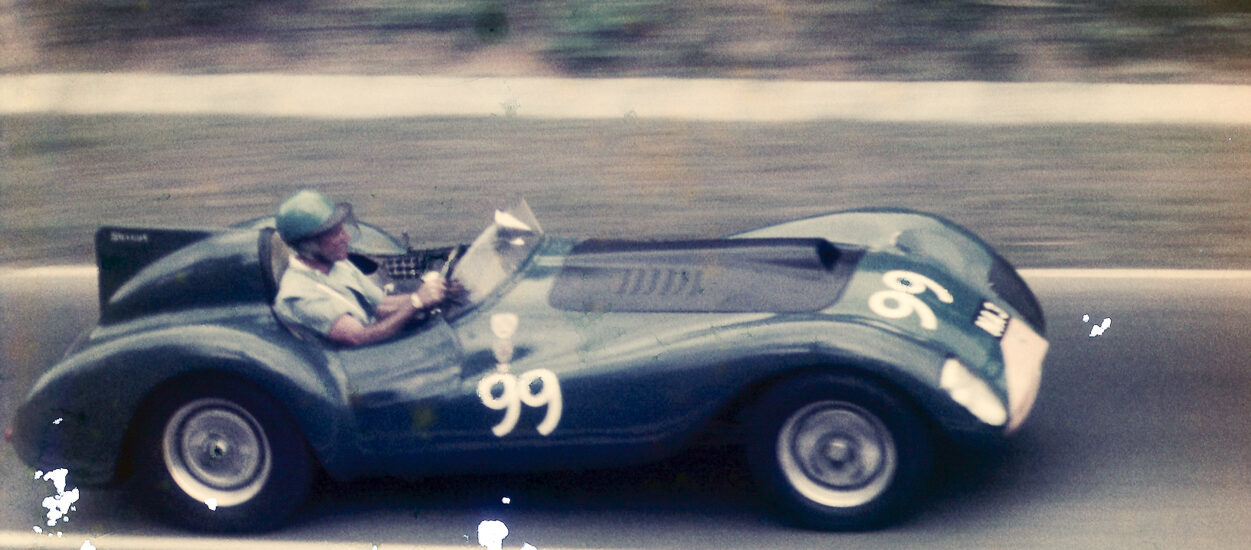
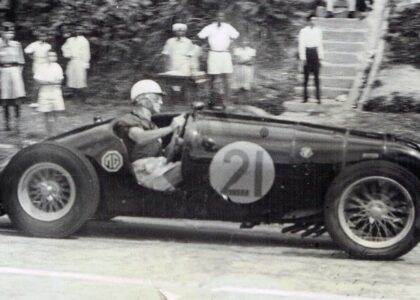
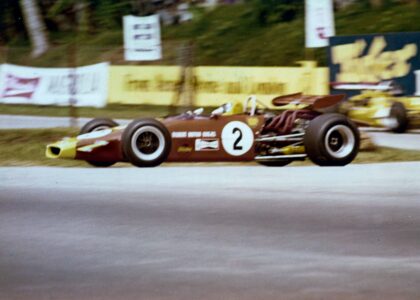
2 thoughts on “JUNGLE WARRIOR – The Warrior Bristol in South East Asia”